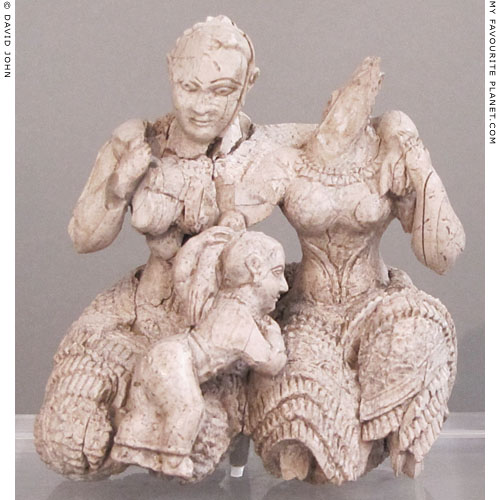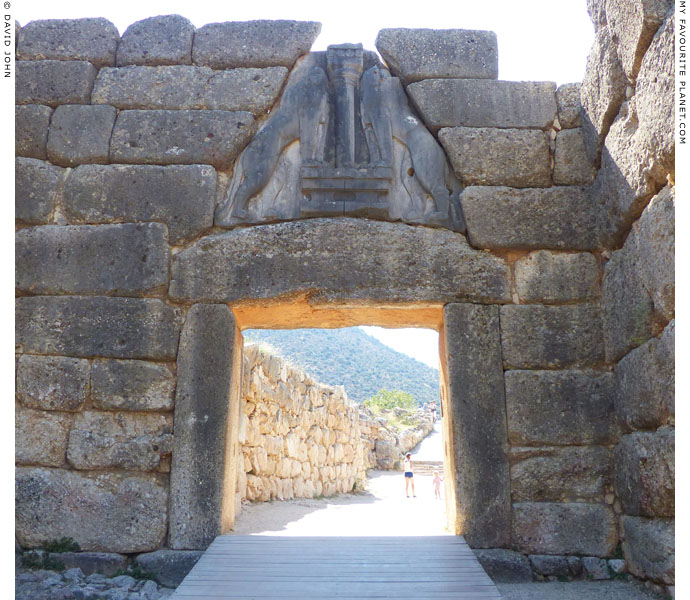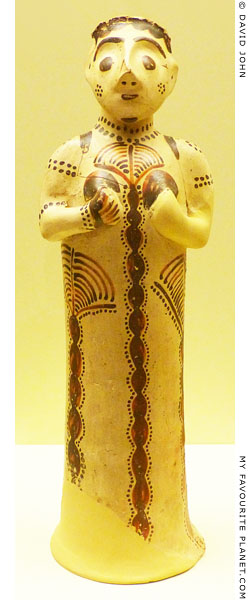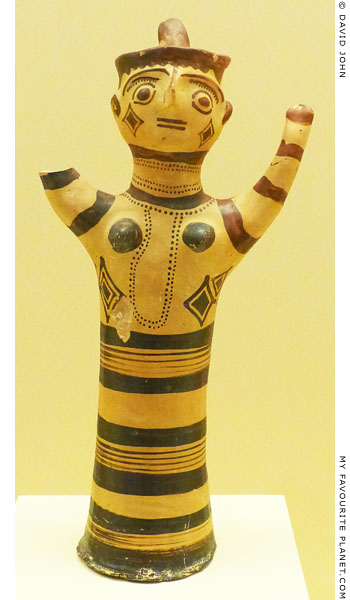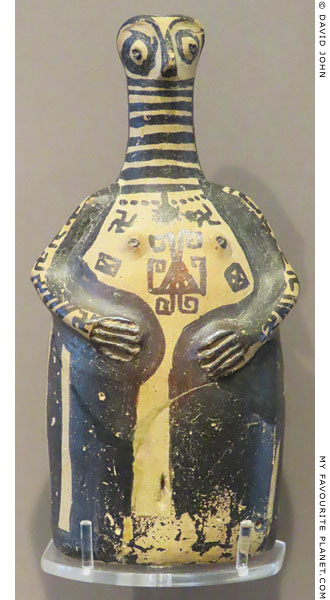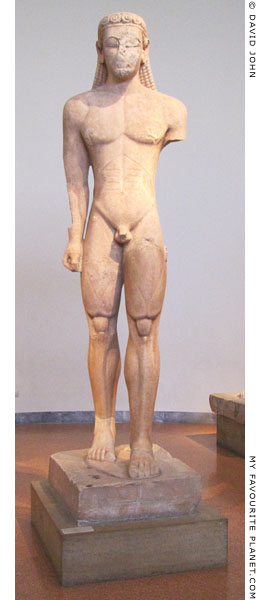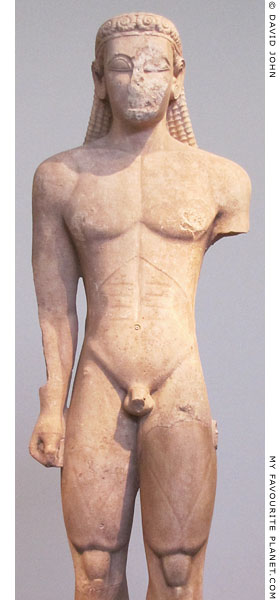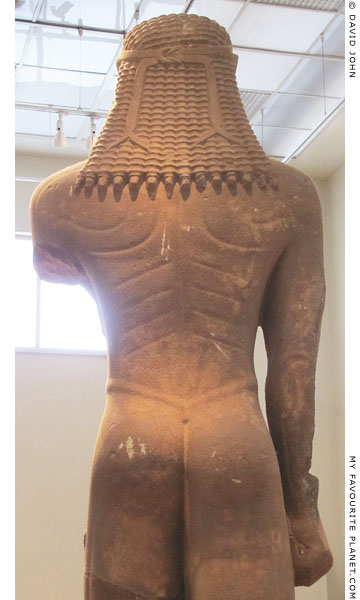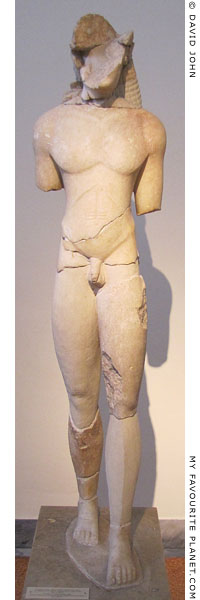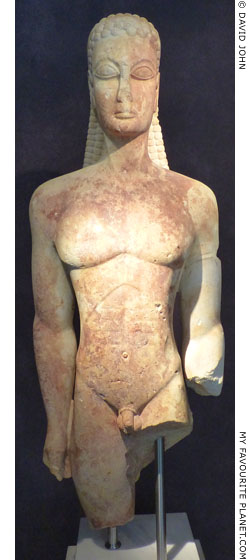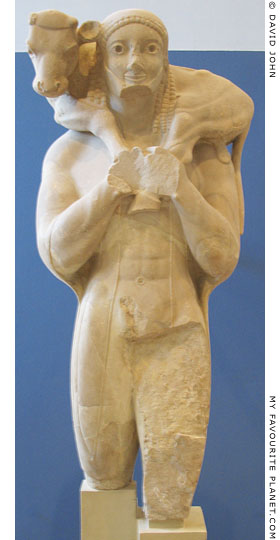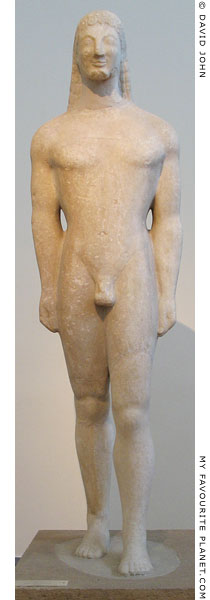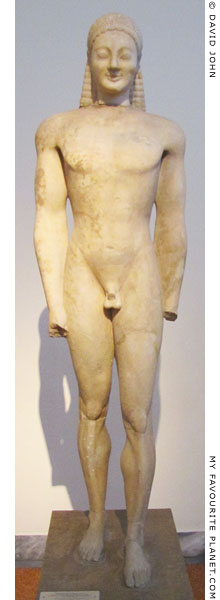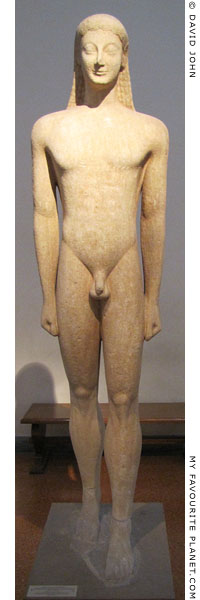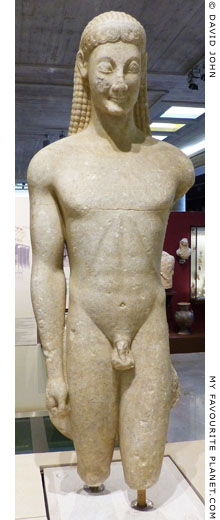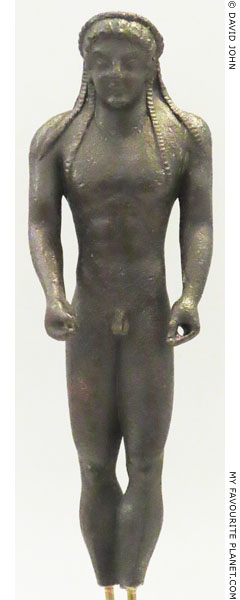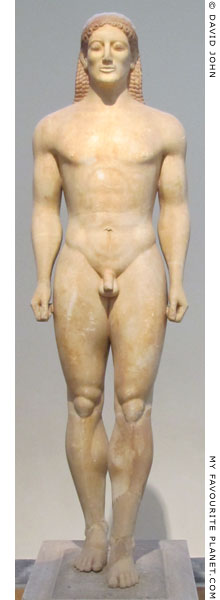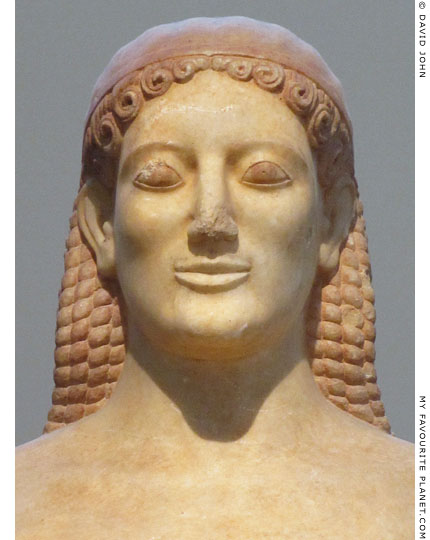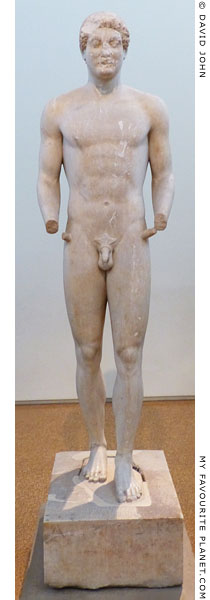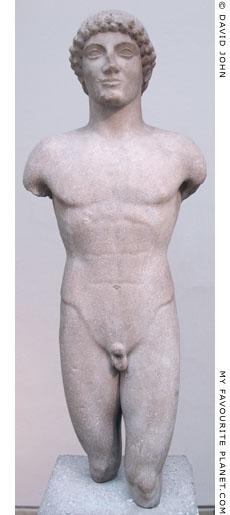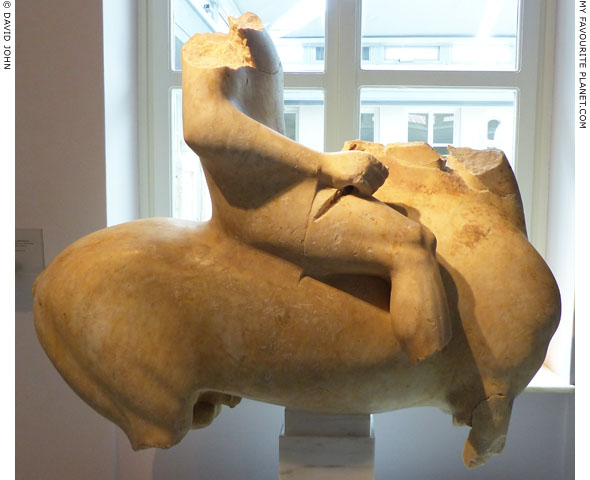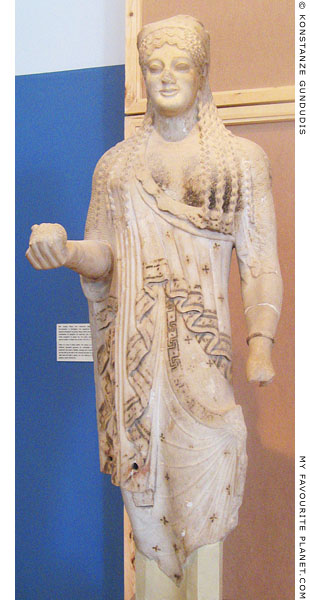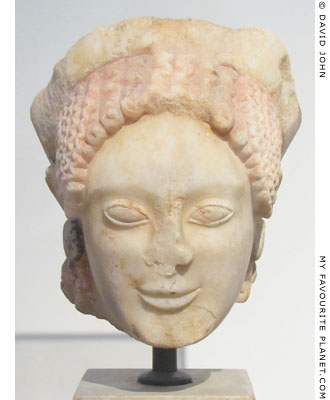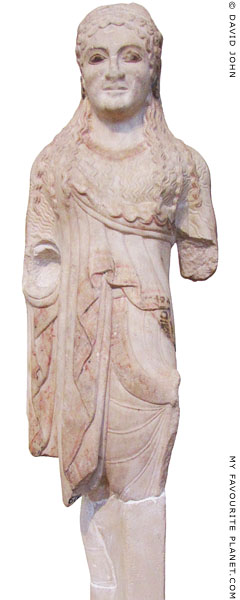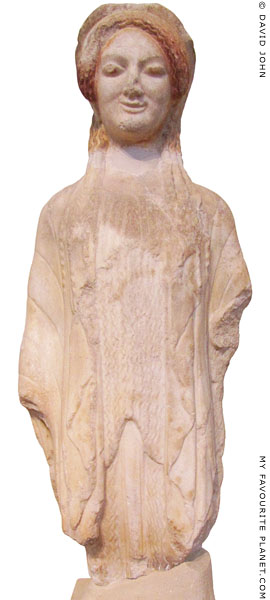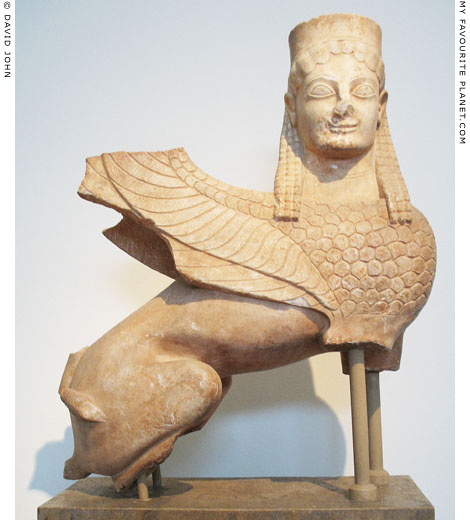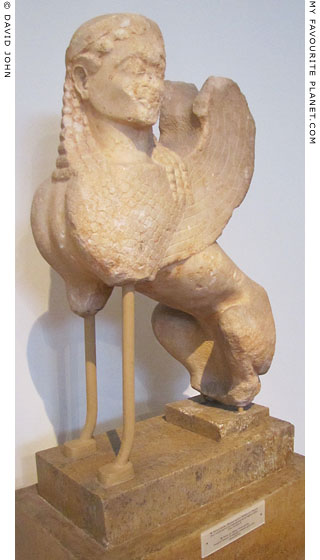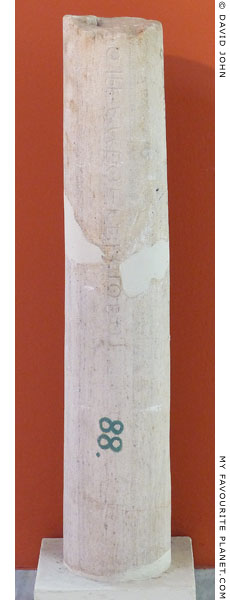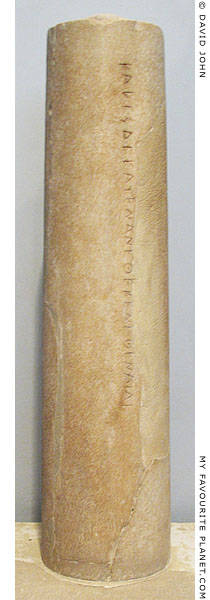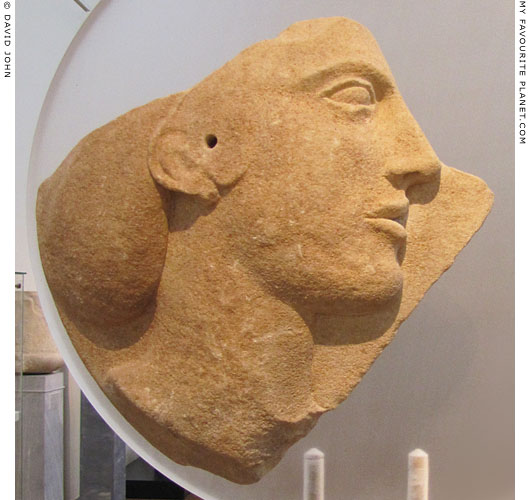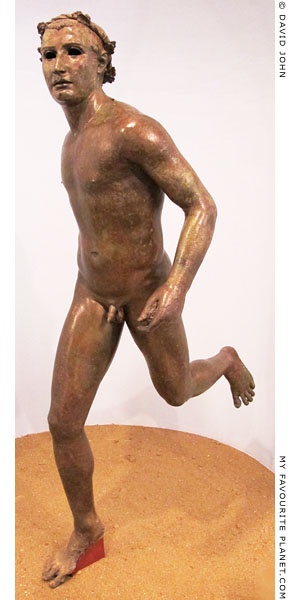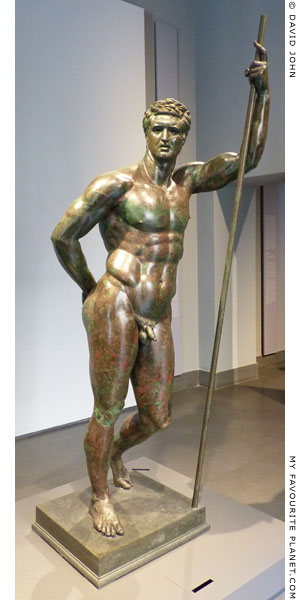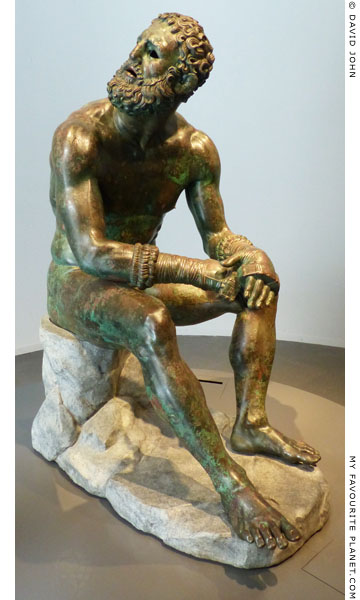|
|
|
| My Favourite Planet > English >
People > Ancient Greek artists> Sculptors A-D |
| MFP People |
Ancient Greek artists – page 2 |
 |
Page 2 of 14 |
 |
|
| |
| Sculptors A - D |
| |
| A B
C D |
The satirist and rhetorician Lucian of Samosata (circa 125-180 AD) wrote that as a youth he was sent to learn to be a sculptor from his uncle "who had the reputation of being an exellent sculptor". He thought it would be a piece of cake, but after the bitterly disappointing first day of his apprenticeship he had a dream in which two women appeared to him. The first introduced herself as "Sculpture" (or "the trade of Sculpture"; Ἑρμογλυφικὴ τέχνη, literally the art of carving Hermes statues), who attempted to persuade him of the benefits of a life as a sculptor. She is described as looking "like a workman, masculine, with unkempt hair, hands full of callous places, clothing tucked up, and a heavy layer of marble dust upon her, just as my uncle looked when he cut stone."
The second woman, "Education" (Παιδεία), more attractive, dignified and elegant, countered Sculpture's arguments, and warned him of the hardships and lowly status he would have to endure as a sculptor:
"What it shall profit you to become a sculptor, this woman has told you; you will be nothing but a labourer, toiling with your body and putting in it your entire hope of a livelihood, personally inconspicuous, getting meagre and illiberal returns, humble-witted, an insignificant figure in public, neither sought by friends nor feared by your enemies nor envied by your fellow citizens - nothing but just a labourer, one of the swarming rabble, ever cringing to the man above you and courting the man who can use his tongue, leading a hare's life, and counting as a godsend to anyone stronger.
Even if you should become a Phidias or a Polycleitus and should create many marvellous works, everyone would praise your craftsmanship, to be sure, but none of those who saw you, if he were sensible, would pray to be like you; for no matter what you might be, you would be considered a mechanic, a man who has naught but his hands, a man who lives by his hands."
The Dream or Lucian's Career (also known as The Vision; Greek, Περὶ τοῦ Ἐνυπνίου ἤτοι Βίος Λουκιανοῦ; Latin, Somnium sive Vita Luciani). In: Lucian, with an English translation by A. M. Harmon, Volume 3 (of 8), pages 218-223. Loeb Classical Library. William Heinemann, London and G. P. Putnam's Sons, New York, 1921. |
|
|
| |
|
| |
| Name / Biographical information |
|
Works / References |
|
| |
Adymos of Veroea
Ἅδυμος (Latin, Adymus)
1st century AD
From Veroea (Βέροια), Macedonia
He was the son of Evandros, perhaps
Evandros of Veroea.
It is thought that Evandros and Adymos belonged to a family of sculptors who undertook commissions around Macedonia and Thessaly. They both made grave monuments and, unusually, signed their name on them; most sculptors of the time remain anonymous. This suggests that they had a high reputation in the region. |
|
The only surviving sculpture by Adymos, is the lower part of a marble grave column, discovered in 1932 at the village of Marvinci, Valandovo, Republic of North Macedonia (near the border with Greece), probably the site of the ancient Paeonian city Idomeneo. It has a bas-relief of the lower part of a woman wearing a sleeved cloak, to the right of which is the inscription:
Ἅδυμος Εὐάνδρου Βεροιαῖος ἐποίει
Adymos, son of Evandros, of Veroea, made it.
Inscription SEG 18:272.
Skopje Archaeological Museum.
Height 31 cm, width 28 cm, depth 13 cm. |
|
| |
Aetion
Αετίων
(Sometimes erroneously referred to as Eetion, Hetion or Echion)
Sculptor and painter?
Mid 4th - early 3rd century BC
Perhaps from Amphipolis, Macedonia |
|
A sculptor named Aetion is known from references by Pliny the Elder, Theocritus and Callimachus. Aetion as a painter is mentioned by Cicero, Pliny and Lucian of Samosata, who described a painting of the Marriage of Alexander the Great and Roxana.
See the Aetion page for further details. |
|
|
| |
Agamedes of Argos (?)
Αγαμεδες Αργειος
Or Polymedes of Argos. The existence of either artist depends on the interpretation of a single, incomplete inscription.
Early 6th century BC, from Argos, northeastern Peloponnese
The base of one of the twin marble kouroi statues known as "Kleobis and Biton", excavated at Delphi and dated to around 580 BC, is inscribed with an artist's signature, the first letters of which are no longer legible:
[---]ΜΕΔΕΣ ΕΠΟΙΗΣΕΗ ΑΡΓΕΙΟΣ
([---]medes of Argos made me)
The name has been reconstructed by some scholars as Polymedes of Argos (Πολυμεδες Αργειος), while others believe it is Agamedes of Argos (Αγαμεδες Αργειος). Both these are otherwise unknown as names of sculptors.
Andrew Stewart is one of those who prefer Agamedes:
"Before Hageladas, the only known Argive sculptor is [Aga]medes, who signed the twins at Delphi ca. 580 (Delphi, Kleobis and Biton; Stewart 1990, figs. 56-57)."
Hageladas of Argos in the chapter The Archaic Period. In: Andrew Stewart, One Hundred Greek Sculptors, Their Careers and Extant Works. At Perseus Digital Library.
The statues were originally identified as the brothers Kleobis and Biton of Argos. Herodotus related the legend of the brothers and wrote that "the Argives made and dedicated at Delphi statues of them as being the best of men". (Histories, Book 1, chapter 31). However, this identification has been questioned, and according to one theory the statues may depict the Dioskouroi.
The brothers Agamedes and Trophonios (Ἀγαμήδης καὶ Τροφώνιος) are mentioned by ancient authors as the architects of the first temple of Apollo at Delphi. While the earliest temple is thought to have been built around the 7th century BC, the stories concerning these brothers are generally considered legend or myth. Strangely, one of the stories concerning their deaths is similar to that of Kleobis and Biton. |
|
|
| |
Ageladas of Argos
Ἀγελάδας; Ageladas or Hageladas; also Agelades (Pliny the Elder, Natural History, Book 34, chapter 19)
Working around 520-450 BC
From Argos, eastern Peloponnese
Pausanias mentioned a sculptor named Ageladas eight times (Description of Greece, books 4, 6, 7, 8, 10), six times as "Ageladas of Argos", who he said was a contemporary of Onatas and Hegias of Athens (Book 8, chapter 42, section 10).
The scholiast (commentator) on Aristophanes' Frogs (line 504), named Ageladas as the teacher of Pheidias. However, he also wrote that he made the statue of Herakles Alexikakos (Ἡρακλῆς Ἀλεξίκακος, the averter of evil) set up in the Attic deme of Melite to commemorate the deliverance from the great plague (87th Olympiad, 432 BC; two outbreaks in 430/429 and 427/426 BC, Thucydides, History of the Peloponnesian War, Book 2, chapter 47) during the Peloponnesian War. This is probably too late for the assumed dates of his career. It has been suggested that if the statue was by Ageladas, it may have been renamed or rededicated around the time of the plague.
(A statue of Apollo Alexikakos by Kalamis was set up around the same time in the Athenian Agora. See Kalamis 1.)
Pliny the Elder mentioned a sculptor named Agelades, working in bronze during the 87th Olympiad (432 BC), at the same time as Kallon (probably Kallon of Elis) and Gorgias the Laconian (see Gorgias), after the date he gave for Pheidias in the 83rd Olympiad (448 BC). He also wrote that he was the teacher of Polykleitos and Myron (Natural History, Book 34, chapter 19).
In view of his estimated long career of around 70-80 years, it has been suggested that ancient authors may have been referring to two artists of this name, one from Argos and the other from Sikyon, or made errors in their attributions of works. Other scholars have seen the claims that he was the teacher of Pheidias, Myron, and Polykleitos as later traditions or inventions.
Pausanias mentioned three statues by Ageladas of Argos at Olympia, all thought to have been in bronze:
A statue of the pankration champion Timasitheos, from Delphi, who was later executed by the Athenians for his participation in the Spartan-backed attempt by the aristocrat Isagoras (Ἰσαγόρας) to establish a tyranny in 507 BC (also mentioned by Herodotus, Histories, Book 5, chapter 72).
Pausanias, Description of Greece, Book 6, chapter 8, section 5. At Perseus Digital Library.
The chariot of Kleosthenes, from Epidamnos, a victor in the 66th Olympic Games.
"Next to Pantarces is the chariot of Cleosthenes, a man of Epidamnus. This is the work of Ageladas, and it stands behind the Zeus dedicated by the Greeks from the spoil of the battle of Plataea. Cleosthenes' victory occurred at the sixty-sixth Festival, and together with the statues of his horses he dedicated a statue of himself and one of his charioteer. There are inscribed the names of the horses, Phoenix and Corax, and on either side are the horses by the yoke, on the right Cnacias, on the left Samus. This inscription in elegiac verse is on the chariot:
'Cleosthenes, son of Pontis, a native of Epidamnus, dedicated me
After winning with his horses a victory in the glorious games of Zeus.'
This Cleosthenes was the first of those who bred horses in Greece to dedicate his statue at Olympia."
Description of Greece, Book 6, chapter 10, sections 6-8.
"... Ageladas of Argos made the statue of Anochus of Tarentum, the son of Adamatas, who won victories in the short and double foot-race."
Description of Greece, Book 6, chapter 14, section 11.
Pausanias also wrote that Ageladas made the cult statue of Zeus in the sanctuary of Zeus Ithomatas on Mount Ithome, the ancient acropolis of Messenia.
"The statue of Zeus is the work of Ageladas, and was made originally for the Messenian settlers in Naupactus."
Description of Greece, Book 4, chapter 33, section 2. At Perseus Digital Library.
Refugees from Messene, southwest Peloponnese, fleeing from Spartan domination at the end of the Third Messenian War, were settled by the Athenians at Naupaktos (Ναύπακτος), on the north coast of the Gulf of Corinth, in 456/455 BC. The statue of Zeus would then have been either one of the last works of Ageladas of Argos or by the conjectural Ageladas of Sikyon.
Ageladas made bronze statues of Zeus and Herakles for the city of Aigion (Αἴγιον), Achaia in the northwestern Peloponnese.
"There are at Aegium other images made of bronze, Zeus as a boy and Heracles as a beardless youth, the work of Ageladas of Argos."
Description of Greece, Book 7, chapter 24, section 4. At Perseus Digital Library.
At Delphi, Pausanias reported on two statue groups dedicated by the Spartan colony Tarentum (Greek, Τάρᾱς, Taras; today Taranto), Apulia, southern Italy. He said the first was by Ageladas of Argos.
"The bronze horses and captive women dedicated by the Tarentines were made from spoils taken from the Messapians, a non-Greek people bordering on the territory of Tarentum, and are works of Ageladas the Argive."
Pausanias, Description of Greece, Book 10, chapter 10, section 6. At Perseus Digital Library.
The second statue group, made by Onatas of Aegina and perhaps Ageladas of Argos, depicted cavalry and infantry standing by Taras and Phalanthos bestriding the slain native king Opis.
"The Tarentines sent yet another tithe to Delphi from spoils taken from the Peucetii, a non-Greek people. The offerings are the work of Onatas the Aeginetan, and Ageladas the Argive, and consist of statues of footmen and horsemen – Opis, king of the Iapygians, come to be an ally to the Peucetii. Opis is represented as killed in the fighting, and on his prostrate body stand the hero Taras and Phalanthus of Lacedaemon, near whom is a dolphin. For they say that before Phalanthus reached Italy, he suffered shipwreck in the Crisaean sea, and was brought ashore by a dolphin."
Description of Greece, Book 10, chapter 13, section 10.
However, the Greek text of this passage is corrupt and the name of the second artist is unclear. It has also been conjecturally interpreted as Kalliteles (Καλλιτέλης) or Kalynthos (Κάλυνθος). Kalliteles has been suggested because Pausanias mentioned him as Onatas' assistant on a statue of Hermes Kriophoros at Olympia, while Kalynthos is unknown as an artist in ancient literature. See the Onatas of Aegina page for further details.
Statues of three Muses as personifications of the diatonic, chromatic and enharmonic styles of Greek music by Aristokles, Kanachos and Ageladas were described in an epigram by the Greek poet Antipater of Sidon (Ἀντίπατρος ὁ Σιδώνιος) in the 2nd century BC.
"Three are we, the Muses who stand here; one bears in her hands a flute, another a harp, and the third a lyre. She who is the work of Aristocles holds the lyre, Ageladas' Muse the harp, and Canachas' the musical reeds. The first is she who rules tone, the second makes melody of colour, and the third invented skilled harmony."
William Roger Paton (translator), The Greek Anthology, Volume 5 (of 5), Book 16, Epigrams of the Planudean Appendix, No. 220, pages 290-291. In Greek and English. William Heinemann, London; G.P. Putnam's Sons, New York, 1925. At the Internet Archive.
It is not known where these statues stood or whether they were all made at the same time, perhaps as a collaboration between three sculptors. |
|
|
| |
Agesander of Rhodes
Άγήσανδρος
(Referred to as Agesandros, Hagesander, Hagesandros, Hagesanderus)
From Rhodes, 1st century BC - 1st century AD, Roman Imperial period
The marble statue group "Laocoön and his sons" (see below), now in the Vatican Museums, is thought to be the work praised by Pliny the Elder, who wrote that it was made by three Rhodian artists, Hagesander, Polydorus and Athenodorus. Pliny is the only ancient author to mention them. After listing a number of marble sculptures by Greek artists, many of which had been taken to Rome, he stated:
"Beyond these, there are not many sculptors of high repute; for, in the case of several works of very great excellence, the number of artists that have been engaged upon them has proved a considerable obstacle to the fame of each, no individual being able to engross the whole of the credit, and it being impossible to award it in due proportion to the names of the several artists combined. Such is the case with the Laocoön, for example, in the palace of the Emperor Titus, a work that may be looked upon as preferable to any other production of the art of painting or of statuary. It is sculptured from a single block, both the main figure as well as the children, and the serpents with their marvellous folds. This group was made in concert by three most eminent artists, Hagesander, Polydorus, and Athenodorus, natives of Rhodes."
Pliny the Elder, Natural History, Book 36, chapter 4. At Perseus Digital Library.
The names in the Latin text are "Hagesander et Polydorus et Athenodorus rhodii".
The style of the Laocoön Group has been described as "Hellenistic Baroque" or "Pergamene Baroque" and compared with other Hellenistic sculptures such as the reliefs on the Great Altar of Zeus in Pergamon. It is thought that it was made around the first century AD, perhaps before 79 AD, as a copy of a bronze sculpture created around 200 BC in Pergamon.
The Sperlonga sculptures, a collection of fragmented colossal marble statue groups, each depicting a scene of Odysseus' adventures from Homer's Odyssey, was discovered in 1957 in a grotto at the Villa of Emperor Tiberius at Sperlonga (ancient Spelunca), on the west coast of Italy, between Rome and Naples. The Scylla Group, dated to before 26 AD, depicts Odysseus' ship being attacked by the monster Skylla. A signature inscribed on the side of a panel on the ship names the three Rhodian sculptors:
Ἀθαν[ό]δωρος
Ἁγησάνδρ[ο]υ
καὶ
Ἁγήσανδρο[ς]
Πα[ιω]νίου
κ[α]ὶ
Π[ο]λ[ύ]δωρος
Πολυ[δ]ώρου
Ῥόδιο[ι] ἐποίησα[ν].
"Athanadoros, son of Agesandros, and Agesandros, son of Paionios, and Polydoros, son of Polydoros, Rhodians, made this."
Inscription SEG 19:623 at The Packard Humanities Institute.
These may be the three artists mentioned by Pliny, although this has been much debated.
The sculptures also include a group depicting Odysseus blinding the Cyclops Polyphemos.
It has been suggested that the three sculptors were copyists, and also that there may have been more than one Agesander, possibly members of the same family. Scholars have attempted to identify the one or more Agesanders on the grounds of artistic style and from these inscriptions, as well as others found in Rhodes and elsewhere.
The signature of a sculptor named Athanadoros, son of Agesandros has been recorded on a number of undated bases found in Italy:
Ἀθανόδωρος Ἀγησά[νδρ]ου
Ῥόδιος ἐποίησε.
Inscription IG XIV 1227. From Nettuno, Antium (Anzio), central Italy.
[Ἀθανό]δωρος Ῥόδιο[ς]
ἐποίησε.
Inscription IG XIV 1228. Provenance unknown. Now in the Bibliothèque nationale de France, Paris.
[Ἀθαν]όδωρος Ἀγησάνδρου
[Ῥ]όδιος ἐποίησε.
Inscription IG XIV 1230. At Ostia, near Rome. |
|
|
| |
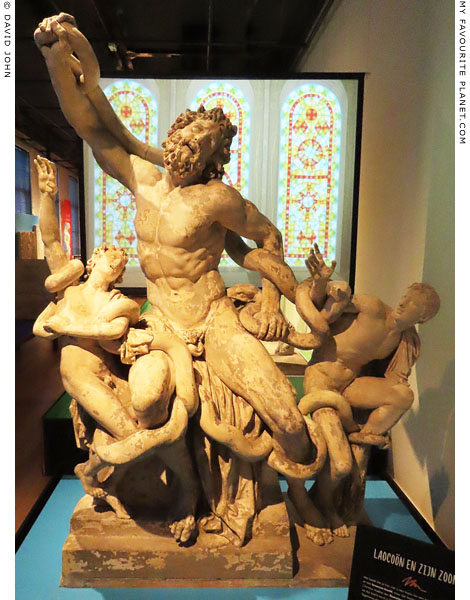
A plaster cast of the statue group "Laocoön and his sons"
by Agesandros, Athenodoros and Polydoros.
1st century BC - 1st century AD, perhaps a copy of
a group made around 200 BC. Height 184 cm.
Allard Pierson Museum, Amsterdam.
The original is in the Cortile Ottagono, Museo Pio-Clementino,
Vatican Museums, Rome. Inv. Nos. 1059, 1064, 1067. |
| |
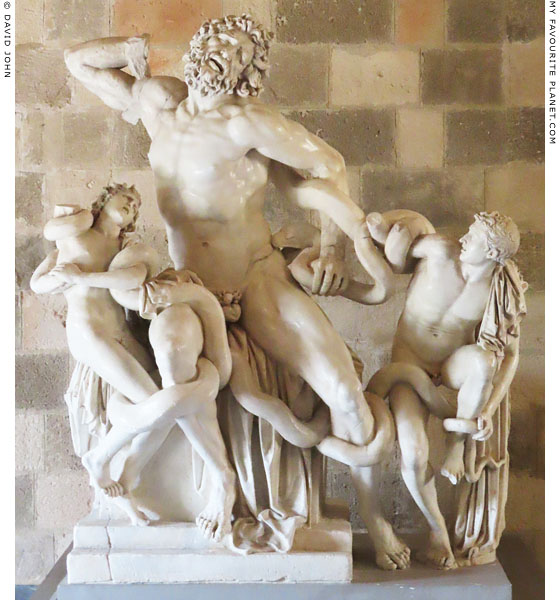
A modern copy of the statue group "Laocoön and his sons" in Rhodes.
Palace of the Grand Master, Rhodes. |
| |
"Laocoön and his sons" (also known as the "Laocoön Group") was discovered on 13th January 1506 by Felice de Fredi on his vineyard, in a vault below the Place de Sette Sale, near Santa Maria Maggiore, Rome. This was the site of part of the palace of Titus, in which Pliny said it stood. Michelangelo Buonarroti and the Florentine architect Giuliano da Sangallo were among those who witnessed the excavation of the sculpture. Fredi ceded it to Pope Julius II, who awarded him a pension, and it was set up in a courtyard of the Belvedere, Rome.
The group is not made of a single block as Pliny claimed, although it has been suggested that originally the joints in the sculpture may not have been not apparent to viewers. Several parts of the figures were missing, and replaced during a number of restorations. Laocoön's right arm was replaced in 1532 by Giovanni Antonio Montorsoli, a pupil of Michelangelo, with one which was outstretched to the right. Two plaster casts commissioned around 1750-1770 by Anton Raphael Mengs (see note on the Niobe page), one now in Dresden, the other in Florence, record the restored sculpture as it appeared in the mid 18th century (Moritz Kiderlen (editor), Die Sammlung der Gisabgüsse von Anton Raphael Mengs in Dresden, page 95, table 6, No. XXIII. Dresden, 2006).
In 1798 the sculpture was taken by Napoleon's troops to Paris and exhibited in the Louvre. On its return to Rome in 1816, it was further restored by Antonio Canova. The plaster cast in Amsterdam and others were made from this version of the work. In 1905 part of the original arm was found by chance in a builder's yard in Rome by the archaeologist and art dealer Ludwig Pollak, director of the Barracco Museum. This was eventually added to the statue in 1960, and during a major restoration in the 1980s other moden additions were also removed.
The sculpture depicts the Trojan seer Laocoön, priest of the Thymbraean Apollo, and his two sons being killed by two giant serpents. There were several ancient versions of the story of Laocoön's death, including those related by Arctinus (the earliest surviving version), Sophocles (in a lost tragedy), Dionysius of Halicarnassus, Quintus Smyrnaeus, Virgil, Servius, Pseudo-Apollodorus, Hyginus and John Tzetzes. It is not known which version may have inspired the work.
According to Virgil (Aeneid, Book 2) Laocoön warned the Trojans of the Wooden Horse with the words: "Equo ne credite, Teucri. Quidquid id est, timeo Danaos et dona ferentes." ("Do not trust the horse, Trojans! Whatever it is, I fear the Greeks, even bringing gifts.") Poseidon (god of the sea and of horses) then sent two sea serpents to strangle him and his sons Antiphantes and Thymbraeus. However, Apollodorus (Pseudo-Apollodorus, Bibliotheka, Epitome, chapter 5, sections 17-18) wrote that the two serpents were sent by Apollo because Laocoön had enraged him by sleeping with his wife in front of the divine image.
See:
Bernard Andreae, 36. Die Lakoongruppe, in: Schönheit des Realismus: Auftraggeber, Schöpfer, Betrachter hellenistischer Plastik, pages 213-229. Verlag Philipp von Zabern, Mainz am Rhein, 1998. At Heidelberg University Digital Library. |
|
|
| |
|
Agorakritos of Paros
Ἀγοράκριτος (Latin, Agoracritus)
From Paros; he worked in Athens around 436-424 BC.
According to Strabo and Pliny the Elder, Agorakritos was from the Cycladaic island of Paros. Pliny wrote that he was a pupil of Pheidias at the same time as Alkamenes, adding that he was a "great favourite" of his teacher. Pausanias went further and referred to him as Pheidias' lover (ἐρωμένος, eromenos).
Pliny mentioned a marble statue of Nemesis (Νέμεσις, Retribution) by Agorakritos at Rhamnous (Ῥαμνοῦς), north of Marathon, northeastern Attica (see below) as well as a statue in the Temple of the Great Mother in Athens. The latter is believed to have been a statue of Kybele (Κυβέλη) in the Metroon (Μητρῷον, a sanctuary dedicated to a mother goddess) in the Agora, which also housed the archives of the city.
"Another disciple also of Phidias was Agoracritus of Paros, a great favourite with his master, on account of his extremely youthful age; and for which reason, it is said, Phidias gave his own name to many of that artist's works.
The two pupils entering into a contest as to the superior execution of a statue of Venus [Aphrodite], Alcamenes was successful; not that his work was superior, but because his fellow citizens chose to give their suffrages in his favour in preference to a stranger. It was for this reason, it is said, that Agoracritus sold his statue, on the express condition that it should never be taken to Athens, and changed its name to that of Nemesis. It was accordingly erected at Rhamnus, a borough of Attica, and M. Varro has considered it superior to every other statue.
There is also to be seen in the Temple of the Great Mother [Kybele], in the same city, another work by Agoracritus."
Pliny, Natural history, Book 36, chapter 4. At Perseus Digital Library.
Strabo recorded that some sources attributed the statue of Nemesis to Agorakritos while others credited Diodotus (otherwise unknown):
"Rhamnus has the statue of Nemesis, which by some is called the work of Diodotus and by others of Agoracritus the Parian, a work which both in grandeur and in beauty is a great success and rivals the works of Pheidias."
Strabo, Geography, Book 9, chapter 1, section 17. At Perseus Digital Library.
Some modern scholars have rejected Pliny's tale of a competition with Alkamenes and doubted the idea that a statue of Aphrodite could be modified to depict Nemesis.
Pausanias (Description of Greece, Book 1, chapter 33) wrote that Pheidias made a statue of Nemesis for her sanctuary at Rhamnous from a block of Parian marble the Persians had brought to Attica to make a victory trophy, and had presumably abandoned following their defeat at the Battle of Marathon in 490 BC (see the first Persian invasion of Greece). He also described the relief on the base of statue, fragments of which have survived, depicting the mythical scene Helen of Troy being led by Leda (her mother) to Nemesis (in some myth versions her real mother, see the Dioskouroi page), attended by associated figures, including Tyndareos and his children, as well as Agamemnon, Menelaos and Pyrrhus (also known as Neoptolemos), the son of Achilles.
"[2] About sixty stades from Marathon as you go along the road by the sea to Oropus stands Rhamnus. The dwelling houses are on the coast, but a little way inland is a sanctuary of Nemesis, the most implacable deity to men of violence. It is thought that the wrath of this goddess fell also upon the foreigners who landed at Marathon. For thinking in their pride that nothing stood in the way of their taking Athens, they were bringing a piece of Parian marble to make a trophy, convinced that their task was already finished.
[3] Of this marble Pheidias made a statue of Nemesis, and on the head of the goddess is a crown with deer and small images of Victory. In her left hand she holds an apple branch, in her right hand a cup on which are wrought Aethiopians. As to the Aethiopians, I could hazard no guess myself, nor could I accept the statement of those who are convinced that the Aethiopians have been carved upon the cup be cause of the river Ocean. For the Aethiopians, they say, dwell near it, and Ocean is the father of Nemesis."
Sections 4-6 are a digression about the geography of Ocean.
"[7] Neither this nor any other ancient statue of Nemesis has wings, for not even the holiest wooden images of the Smyrnaeans have them, but later artists, convinced that the goddess manifests herself most as a consequence of love, give wings to Nemesis as they do to Love. I will now go onto describe what is figured on the pedestal of the statue, having made this preface for the sake of clearness. The Greeks say that Nemesis was the mother of Helen, while Leda suckled and nursed her. The father of Helen the Greeks like everybody else hold to be not Tyndareus but Zeus.
[8] Having heard this legend Pheidias has represented Helen as being led to Nemesis by Leda, and he has represented Tyndareus and his children with a man Hippeus by name standing by with a horse. There are Agamemnon and Menelaus and Pyrrhus, the son of Achilles and first husband of Hermione, the daughter of Helen. Orestes was passed over because of his crime against his mother, yet Hermione stayed by his side in everything and bore him a child. Next upon the pedestal is one called Epochus and another youth; the only thing I heard about them was that they were brothers of Oenoe, from whom the parish has its name."
Pausanias (Description of Greece, Book 1, chapter 33, sections 2-3 and 7-8. At Perseus Digital Library.
Byzantine writers (John Tzetzes, Chiliades, 7, 154; Suidas; Photius) said that Pheidias made the Nemesis and presented it to his favourite pupil Agorakritos.
Parts of a statue head in the British Museum and fragments of reliefs from a pedestal in the National Archaeological Museum, Athens are thought to be parts of the statue of the Rhamnous Nemesis, but are said to be of Pentelic rather than Parian marble.
Again, according to Pausanias (and Arrian, Periplous, 9) the cult statue in the Metroon, the sanctuary of the Mother of the gods (Μητηρ Θεων, Meter Theon), on the southwest side of the Athens Agora was made by Pheidias.
"Here is built also a sanctuary of the Mother of the gods; the image is by Pheidias."
Pausanias, (Description of Greece, Book 1, chapter 3, section 5. At Perseus Digital Library.
It is thought that the cult statue depicted Kybele enthroned, with a lion attendant, and holding a tympanon (drum). Several dozen dedicatory reliefs of this image, perhaps based on the statue, have been found in the Agora (see photo below). It may have been the model for large number of images of Kybele, made all over the Graeco-Roman world into late Antiquity. The type originated in much more ancient Anatolian depictions of the enthroned Phrygian mother goddess, the oldest known example of which may be a terracotta statue, dated to around 6000 BC, from Çatalhöyük, Turkey, now in the Ankara Archaeological Museum.
From around the 7th century BC, the Kybele cult was adopted by Greeks in Anatolia (Asia Minor), from where it spread to Thrace (e.g. Samothraki) and central Greece (e.g. Thebes), and was finally accepted by the Athenians in the 5th century BC. The statue in the Agora is thought to have been made around 440-420 BC, presumably shortly after the sanctuary was established.
The confusion surrounding the authorship of this statue and the Nemesis at Rhamnous appears to be reflected in the comment by Pliny that "Phidias gave his own name to many of that artist's works" and the Byzantine claim that Pheidias gave his Nemesis to Agorakritos. It seems unlikely that two statues of each goddess, one by Pheidias and the other by Agorakritos, were commissioned for or purchased by the respective sanctuaries around the same time. (The temple of Apollo Patroos in the Agora had three statues of Apollo, although two stood outside, and they were made over a longer period. See Kalamis.) The literary sources lead one to speculate that in each case a statue by Pheidias may have been attributed to Agorakritos or vice versa.
Pausanias also reported that Agorakritos made bronze statues of Athena Itonia and Zeus for the goddess' temple near Koroneia (Κορώνεια), Boeotia.
"Before reaching Coroneia from Alalcomenae we come to the sanctuary of Itonian Athena. It is named after Itonius the son of Amphictyon, and here the Boeotians gather for their general assembly. In the temple are bronze images of Itonian Athena and Zeus; the artist was Agoracritus, pupil and loved one [ἐρωμένος, eromenos] of Pheidias."
Pausanias, Description of Greece, Book 9, chapter 34, section 1. At Perseus Digital Library.
It has been suggested that extant Roman period marble sculptures of the Athena Hope-Albani/Farnese type may be copies of the bronze cult statue of Athena Itonia by Agorakritos. However, some scholars believe the original was the statue of Athena Hygieia which stood near the entrance to the Athens Acropolis (see Pyrrhos of Athens for further details).
Other works attributed to Agorakritos and his school or workshop include:
A fragment of a marble statue group from Rhamnous, circa 430-420 BC (see photo below). Two feet and the bottom of a woman's garment, from a group of two figures depicting the abduction of the Nymph Oreithyia by Boreas, which was part of the central akroterion of the temple of Nemesis at Rhamnous. Attributed to Agorakritos. National Archaeological Museum, Athens. Inv. No. 2348.
A marble statue of a youth from Rhamnous, circa 450-400 BC (see photo, above right). Probably Neanias, a local hero of Marathon. Probably a work of the school of Agorakritos. National Archaeological Museum, Athens. Inv. No. 199.
A marble statue of Demeter from Eleusis, circa 420 BC, is thought to have made in the workshop of Agorakritos. Eleusis Archaeological Museum. Inv. No. 5076.
A marble statue of Persephone, circa 420-410 BC, found in Piraeus, is attributed to the school of Agorakritos. National Archaeological Museum, Athens. Inv. No. 176.
A funerary relief found on Aegina (see photo below), possibly by a pupil of Agorakritos. National Archaeological Museum, Athens. Inv. No. 715. |
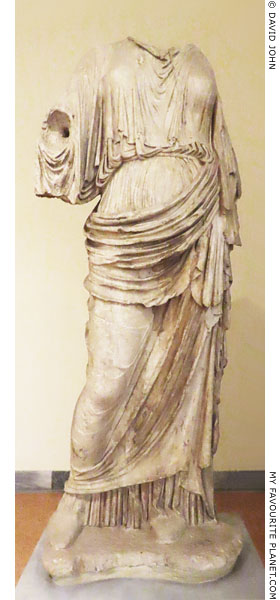
A marble statue of a female, believed
to be a Roman period copy of the cult
statue of Nemesis of Rhamnous, made
by Agorakritos of Paros around 430 BC.
The original depicted the goddess
holding an apple branch and a phiale.
2nd century AD. Found in Athens.
National Archaeological Museum,
Athens. Inv. No. 3949. |
| |
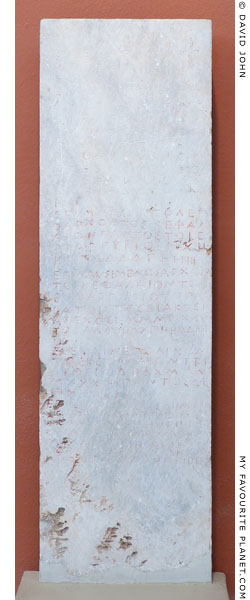
A marble stele inscribed with
the accounts of the sanctuary
of Nemesis at Rhamnous, Attica.
450-440 BC.
Epigraphical Museum, Athens.
Inv. No. EM 12863.
Inscription IG I³ 248. |
| |
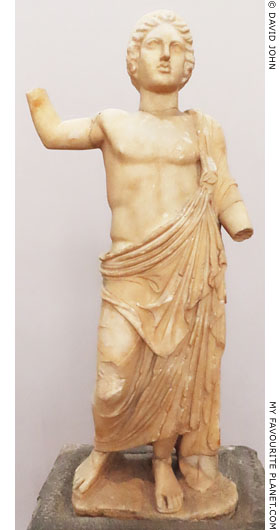
A marble statue of a youth, probably
Neanias (Νεᾱνίᾱς, young man). (At
Marathon Neanias and an unnamed
hero, recieved a third of the sacrificial
budget.) a local hero of Marathon.
Believed to be a work of the school of
Agorakritos. The smaller than lifesize
statue stands on a tall, dark marble
pedestal inscribed with a dedication
to "the goddes" (Nemesis or Themis?)
by Lysikleides, son of Epandrides.
Λυσικλείδης ἀνέθηκ-
εν Ἐπανδρίδο ὑὸς ἀπ{ο}
ἀρχὴν τόνδε θε<ᾶ>ι τῆι-
δε ἣ τόδ’ <ἔ>χει τέμενος
Inscription IG I³ 1021 (also IG I² 828,
Pouilloux, Forteresse de Rhamnonte 36)
Around 450-400 BC. Found in 1890
in the Temple of Themis, Rhamnous.
Pentelic marble. Height 93cm..
National Archaeological Museum,
Athens. Inv. No. 199. |
| |
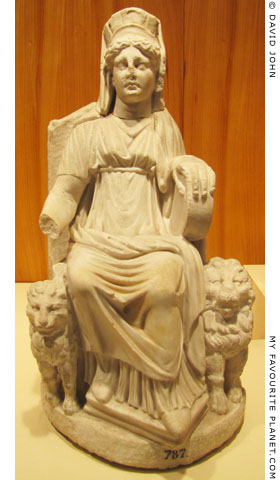
Marble statuette of Kybele sitting
on a throne, on either side of which
is a seated lion. She wears a polos
(or mural crown) and holds a
tympanon (drum) in her left hand.
From Nicaea, Bithynia (Iznik, Turkey).
Roman Imperial period, 2nd century AD,
copy of a Hellenistic original.
Istanbul Archaeological Museum.
Inv. No. 787 T. Cat. Mendel 311. |
| |
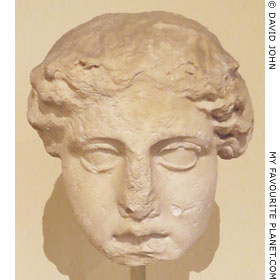
A fragment of a larger than lifesize
marble head of a goddess, probably
from a cult statue. Perhaps unfinished
or reworked. It has been associated
on stylistic grounds with Agorakritos.
Around 420 BC. Unknown provenance.
National Archaeological Museum,
Athens. Inv. No. 4491. |
| |
| |
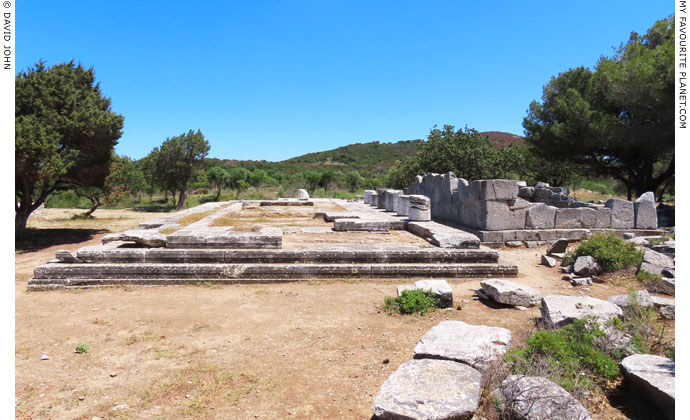
The Sanctuary of Themis and Nemesis, goddesses of Righteousness
and Retribution, within the archaeological site of Rhamnous, north of
Marathon, on the northeast coast of Attica. Viewed from the west.
On the left the surviving platform of the temple of Nemesis, built
around 440-420 BC, and immediately to the right (south) the much
smaller temple of Themis, built around 500-480 BC. |
| |
Rhamnous (Ῥαμνοῦς, buckthorn), over 50 kilometres north of Athens, was an ancient Attic deme, the traditional home of the Aiantis tribe, and the location of a strategically important fortress and harbour on the straits between east Attica and island of Euboea (Εὔβοια). The archaeological site contains the fortified settlement in the valley of Limikon, including a small theatre, gymnasium, temple of Dionysus and a healing sanctuary of Amphiaraos (originally dedicated to the local hero physician Aristomachos), as well as much of its surrounding area, perched high above a long stretch of rocky beaches (linked by a rough coastal path).
Today, the long walk northwards along the old road, now a rough, rocky track, quite steep in places, down from the site entrance to the remains of the fortress affords spectacular views of the settlement, coastal countryside, sea and the mountains of southern Euboea beyond.
The Sanctuary of Themis and Nemesis lay outside the main settlement, on an artificial terrace, partly supported by massive masonry walls, on the brow of a hill above the valley, almost a kilometre south of the main walls of the fortress.
The small Archaic Doric temple dedicated to Themis (Θέμις), built around 500-480 BC, with walls of polygonal limestone blocks and a front porch (pronaos) supported by two columns and the side walls (distyle in antis). Two marble thrones placed in the porch (see below) are taken as evidence that both Themis and Nemesis were worshipped here. Numerous dedications were found in the temple's cella, including a marble statue of Themis, which according to the inscribed base was made by Chairestratos of Rhamnous (see below), although this was made in the late 4th century BC. The temple was used as the treasury of the sanctuary.
Less than half a metre to the north, the much larger, Doric peripteral temple of Nemesis was added to the sanctuary around 440-420 BC. It had 6 columns along its front and back, and 12 along each of its long sides, and its access was oriented a few degrees to the south of that of the older temple. Construction was delayed due to the Peloponnesian War, and eventually many finishing processes, such as the fluting of the columns, were left uncompleted. The cult statue inside the temple is usually attributed to Agorakritos of Paros (see above).
Christians are said to have destroyed the sanctuary in the late 4th century AD.
The first archaeological excavations at Rhamnous were undertaken by the members of the Society of Dilettanti in 1813, and continued in the late 19th century by Dimitrios Filios (1880) and Valerios Stais (1890-1893) of the Archaeological Society of Athens. Following intermittent digs, systematic archaeological investigation of the site was resumed from 1975 by Vasileios Petrakos. |
|
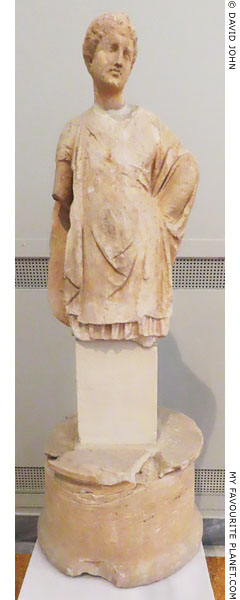
A marble herm of a youth from
Rhamnous. The figure of a youth,
wearing a chiton and a chlamys,
depicted in the round as far as
his knees, stood on a pillar on
an inscribed cylindrical base. The
inscription is a dedication following
a victory in a torch race.
Around 330-320 BC. Pentelic marble.
National Archaeological Museum,
Athens. Inv. No. 313. |
|
| |
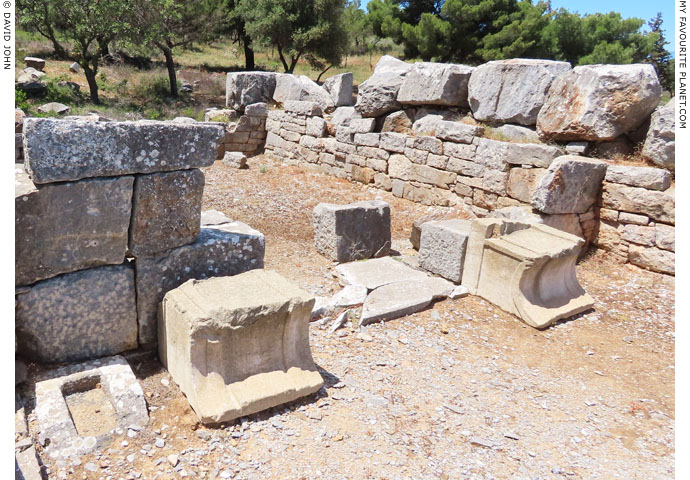
Two marble thrones in the pronaos (front porch), flanking the doorway
to the cella of the Archaic temple of Themis at Rhamnous. |
| |
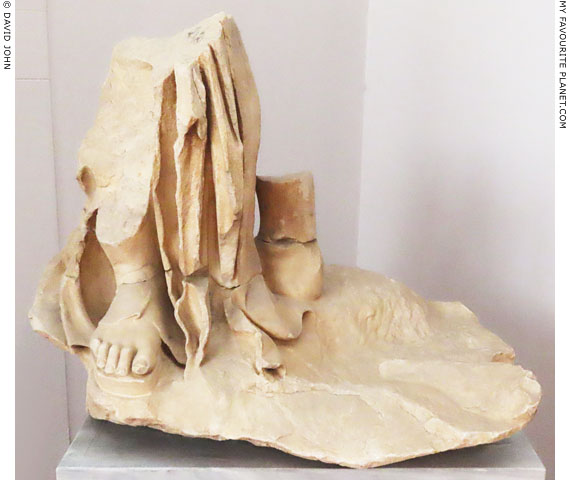
A fragment of a marble statue group from Rhamnous. Two feet and the bottom
of a woman's garment, from a group of two figures depicting the abduction of
the Nymph Oreithyia by Boreas, which was part of the central akroterion
of the temple of Nemesis at Rhamnous. Attributed to Agorakritos of Paros.
Around 430-420 BC. Pentelic marble.
National Archaeological Museum,
Athens. Inv. No. 2348. |
| |
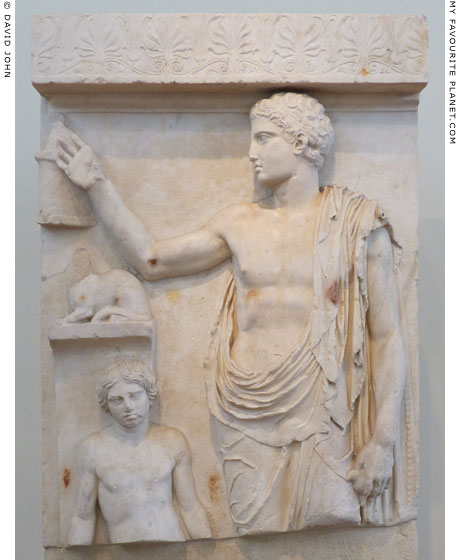
The so-called "Cat Stele", the top of a marble grave stele found
on Salamis or Aegina, with a relief possibly made by a sculptor
who trained in the workshop of Agorakritos of Paros and may
have also worked on the Parthenon frieze.
Around 430-420 BC. Pentelic marble. Height 104 cm.
A standing youth, his head turned to the left, holds a bird in his lowered left hand
and extends his right hand to an empty cage. On the left stands a sad-looking
young attendant (a slave?), depicted at a smaller scale, leaning against a pillar
on top of which is a crouching cat (or sphinx), now headless. If it is a cat, it is
one of the few depicted in Greek art. The horizontal moulding at the top of the
stele is decorated with a relief band of palmettes and lotus flowers.
National Archaeological Museum, Athens. Inv. No. 715.
Following its discovery the stele was taken to the Aegina museum, newly-independent
Greece's first national archaeological museum, established by Governor Ioannis Kapodistrias
in 1829. The work was first recorded and published by the French architect Guillaume Abel
Blouet (1795-1853), head of the architecture and sculpture team of the Institut de France's
Morea Expedition 1829-1833 (see Herodes Atticus). |
| |
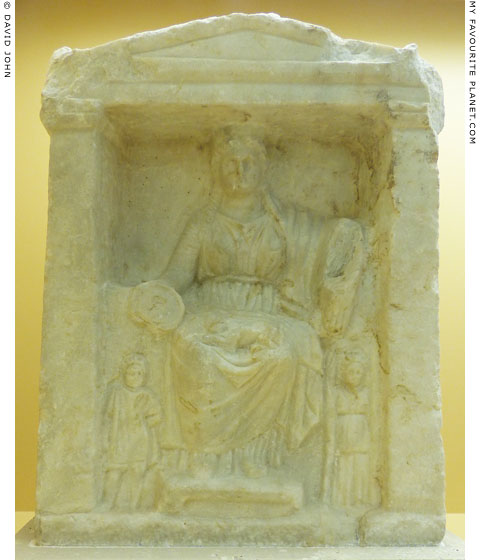
A marble relief of enthroned Kybele in a naiskos (ναΐσκος, small temple).
One of several dozen examples found in the Athenian Agora. Perhaps
a copy of the cult statue by Agorakritos or Pheidias which stood in
the Metroon (Μητρῷον), built in the Agora in the 5th century BC.
Late 4th century BC. Found in the Athenian Agora, 16 May 1937.
Pentelic marble. Height 31 cm, width 23.4 cm, depth 10.3 cm.
The goddess wears a polos and a high-girdled long chiton (tunic). In
other similar reliefs she is shown with a large tympanon (drum) in her
left hand (here missing). Her right forearm is on an amrest of the throne,
and in her right hand she holds a phiale (libation bowl). A lion, shown
at a much smaller scale, lies on her lap, facing left. Her feet are on a
footrest, which is flanked by a small male and female figure.
Agora Museum, Athens. Inv. No. S 922. |
| |
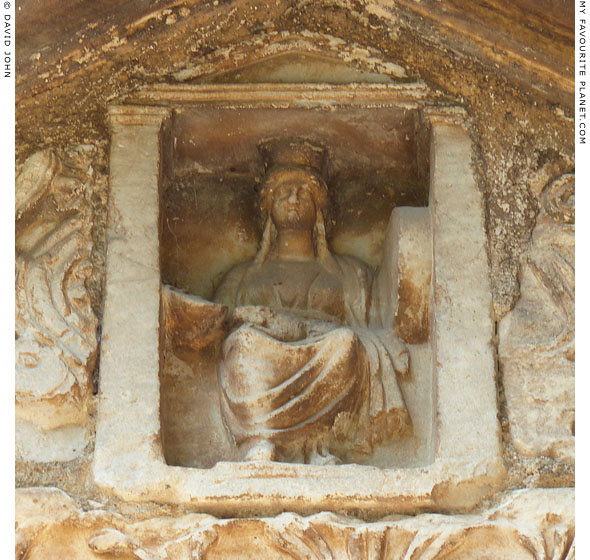
A Marble relief of enthroned Kybele in a naiskos, built into the
east gable of the Byzantine Little Metropolis church in central Athens.
The small Byzantine church of Panagia Gorgoepikoos (Παναγία Γοργοϋπήκοος, the
swift-hearing Virgin), also known as the Little Metropolis (Μικρή Μητρόπολη, Mikri
Mitropoli), and for a short while renamed as the church of Agios Eleutherios (Άγιος
Ελευθέριος), acted as the Metropolitan Cathedral of Athens during the Turkish
occupation, until the much larger modern cathedral was built next to it 1842-1862.
It is not known when the church was built, perhaps as early as the 9th century or
as late as the 15th century. It was constructed using marble spolia, material from
various older pagan and Christian buildings, so that its walls are covered with a
variety of reliefs and inscriptions from different periods. Ancient inscriptions were
also housed inside the church, as well as a Roman period sundial, which is now in
the British Museum (see Athens Acropolis gallery page 36). Attempts have been
made to identify the parts of ancient reliefs built into the walls of the church.
For further information see Demeter and Persephone part 1. |
| |
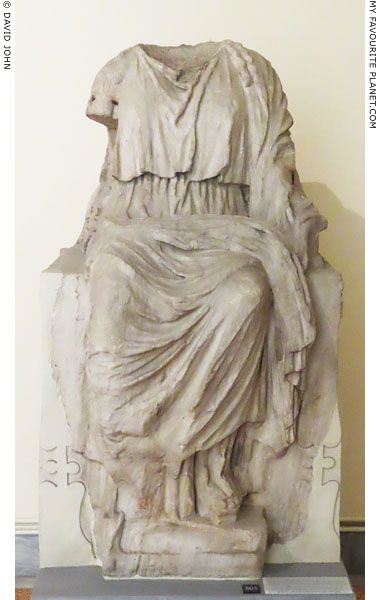
A marble statue of an enthroned goddess, believed to be a
Roman period copy of the cult statue of the Mother of the
Gods by Agorakritos or Pheidias which stood in the Metroon
(Μητρῷον), built in the Athenian Agora around 440 BC.
Found at the junction of Aiolou and Sophokleous streets, Athens.
National Archaeological Museum, Athens. Inv. No. 3265. |
| |
Alexandros of Antioch
Ἀλέξανδρος
or Agesandros of Antioch (Άγήσανδρος)
From Antiochia on the Maeander (Ἀντιόχεια τοῦ Μαιάνδρου), Caria, western Anatolia (today Yenişer, near Başaran, Aydın Province, Turkey).
2nd half of the 2nd century BC
The "Venus de Milo" (Greek, Αφροδίτη της Μήλου, Aphroditi tis Milou, Aphrodite of Milos), now in the Louvre, has become the most famous statue of Aphrodite and one of the best known classical sculptures. Dated to around 130-100 BC, it is thought to depict Aphrodite as Victorious (Latin, Venus Victrix). It was discovered by a Greek farmer on 8th April 1820 on Melos, Greece, when the Cycladic island was still part of the Ottoman Empire. Some scholars have argued that it depicts the sea goddess Amphitrite (consort of Poseidon), who was worshipped on Milos.
The statue was found in two pieces: the head and naked upper torso, and the draped legs attached to part of the base. Also found at the same location were other fragments, including part of the draped right hip, an upper left arm (Inv. No. Ma 401) and a left hand holding an apple (Inv. No. Ma 400), the right side of the base, which was inscribed, as well as two small herms (Inv. Nos. Ma 404 and Ma 405; a third herm, Inv. No. Ma 403, was found later than the other objects). One of the herms depicts Herakles and the other two Hermes.
The inscribed right side of the base (see image below) was examined by scholars when all the fragments were delivered to the Louvre, and it was found to fit exactly to the base fragment below the lower part of the statue. The inscription was an artist's signature:
-----ΑΝΔΡΟΣ -ΗΝΙΔΟΥ
-----ΟΧΕΥΣ ΑΠΟ ΜΑΙΑΝΔΡΟΥ
ΈΠΟΙΗΣΕΝ
The incomplete inscription has been restored as:
Alexandros, son of Menides,
citizen of Antioch of Meander
made it
It has been argued that the name may have been Agesandros (see image below). A number of scholars believed that the statue had been made by Praxiteles, and it was presented to King Louis XVIII as such. (Later it was also suggested the at the statue was by Skopas.) Thus it was assumed that this artist may only have been responsible for a later restoration. Unfortunately - and controversially - the inscribed base fragment disappeared soon after it entered the Louvre.
"Venus de Milo", Louvre, Paris. Inv. No. Ma 399 (LL 299). Parian marble. Height 202 cm. A gift of the Marquis de Rivière, the French ambassador to Ottoman Turkey, to Louis XVIII of France, 1821.
At the time when the fragments were reassembled in the Louvre, the upper left arm and hand were considered to be of inferior workmanship and have not been restored to the statue. The restorers probably considered the statue looked better armless, and in this form it has become an "iconic" representative of classical art. The apple (μῆλον) in the hand is thought to be the Golden Apple won by Aphrodite in the Judgement of Paris. It may also have been a punning reference to the island of Melos (Μηλος).
See:
Gregory Curtis, Base Deception, Smithsonian Magazine, October 2003.
Rachel Kousser, Creating the past: The Vénus de Milo and the Hellenistic reception of Classical Greece. In: American Journal of Archaeology 109 (2005), pages 227-250.
Two inscriptions, dated around 150-100 BC, from Thespiai (Θεσπιαί) in Boeotia, central Greece, where poetry and theatre competitions were held, mention an Alexandros of Antioch, son of Menides, as victor in singing and composing. It has been suggested that this may be the same person.
The same sculptor may also have made the "Inopos", a fragment of the upper part of a marble statue found on Delos, and now also in the Louvre (see photo, right). The fragment, which includes the head and right side of the chest, is in the style of portraits of Alexander the Great. It was initially thought to depict the Delian river god Inopos (Ινωπος), but is now considered to be a Hellenistic ruler, either Alexander himself or Mithradates VI, king of Pontus (circa 120-63 BC).
Louvre, Paris. Inv. No. Ma 855 (MR 235). Circa 100 BC. Height 95 cm. Donated by the painter E. A. Gibelin, 1801.
See: Bust of Alexander the Great, known as the "Inopos", at the Louvre website. |
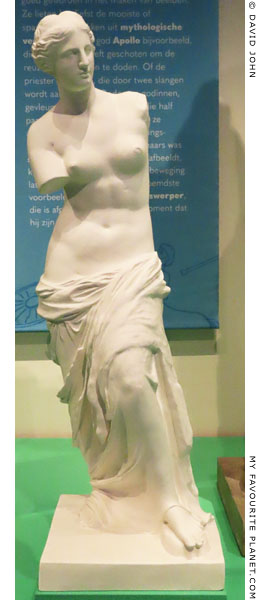
A reduced plaster copy of the
"Venus de Milo" statue, with
the left foot restored.
Rijksmuseum van Oudheden,
Leiden, Netherlands. |
| |
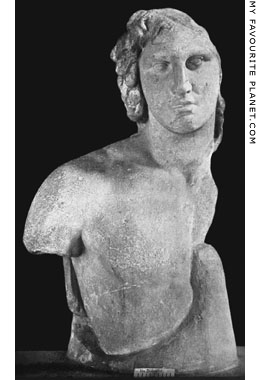
The "Inopos", a fragment of a
statue in the style of portraits
of Alexander the Great.
Around 100 BC. From Delos.
Louvre, Paris. Inv. No. Ma 855.
Source:
Guy Dickens, Hellenistic sculpture,
Fig. 20, page 26. Clarendon Press,
Oxford, 1920. At the Internet Archive. |
| |
| |
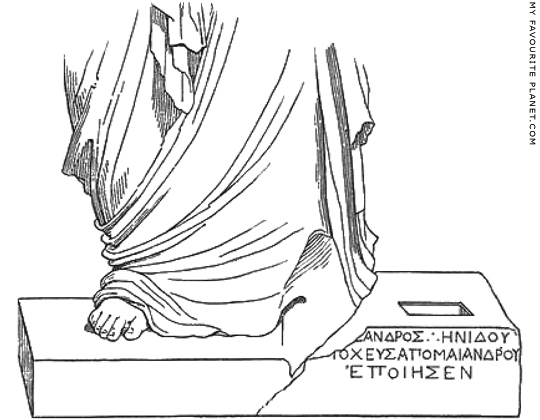
The lower part of the "Venus de Milo", part of a drawing made
by Auguste Debay at the request of Jacques-Louis David.
|
The drawing shows the now missing inscribed base fragment, which was attached to the statue soon after the arrival of all the sculpture fragments in the Louvre. The entire drawing was used as a frontispiece for the pamphlet Sur la statue antique de Vénus Victrix written in 1821 by the Comte de Clarac, Conservateur du Musee Royal des Antiques, in which he was the first to publish the claim that the statue was made by Alexandros of Antioch, much to the displeasure of his colleagues.
The rectangular dowel hole in the top of the base is thought to have been a socket for a herm or pillar. The findspot of the statue has been identified as an exedra (niche) of the city's gymnasium, in which an inscription (also now lost) found above the entrance stated that the assistant gymnasiarch Bakchios, son of Satios (Βάκχιος Σατίου) had dedicated "this exedra and this [statue] to Hermes and Hercules" (inscription IG XII.3.1091). Both gods were associated with gymnasia and baths as patrons, and statues and herms were set up in such buildings.
It is possible that one of the herms discovered with the statue stood alongside Aphrodite. "Piedestal d'un des hermes", a drawing made by the French naval officer Olivier Voutier on Melos at the time of its discovery (published in F. Ravaisson, La Vénus de Milo, Paris, 1892), shows that the herm of Herakles stood next to Aphrodite on the same base. The goddess' left arm may have originally rested on the herm so that it acted as a support for the statue. This was refuted by 19th century art historians, including Adolf Michaelis, who considered the herm to be "of mediocre work", "tasteless" and greatly inferior in quality to the "illuminating beauty" of the "majestic woman of Melos". Michaelis was among those who attributed both statue and herm to Alexandros, although he believed the Venus to be a copy of an earlier work:
"No serious doubt can be entertained that the statue is the work of Alexandros. To him is due the addition of the tasteless herm (a restored copy by the French sculptor Claude Tarral makes this evident), and of the apple (Greek μῆλον), an emblem of the island of Melos; on the other hand we are indebted to him for the excellent reproduction of the body and head of a superb original, probably of the time of Scopas."
Adolf Michaelis, A century of archaeological discoveries, page 51. John Murray, London, 1908. At the Internet Archive.
Image source: Adolf Furtwängler, Meisterwerke der griechischen Plastik (part 1, text), Fig. 117,
page 607. Giesecke & Devrient, Leipzig / Berlin, 1893. At Heidelberg University Digital Library.
English version: Furtwängler, Adolf, Masterpieces of Greek sculpture, edited by Eugénie Sellers
(Strong), Fig. 159, page 371. William Heinemann, London, 1895. At the Internet Archive.
Furtwängler dedicated an entire chapter to the Venus de Milo (pages 367-401 in the English edition), and discussed the block with the inscribed signature at length. He seemed convinced that it belonged with the statue:
"The disappearance of the inscription, in my opinion, is only a proof of its genuineness. It was an awkward witness, and had to be quietly got out of the way." page 369
He also commented on the disappearance of the gymnasiarch's inscription:
"The block with the dedicatory inscription has likewise disappeared (another inconvenient witness hushed up!)." page 377
Strangely, he did not quote or discuss the signature inscription itself or the possible identity of the artist, whose name is not mentioned. |
|
|
| |
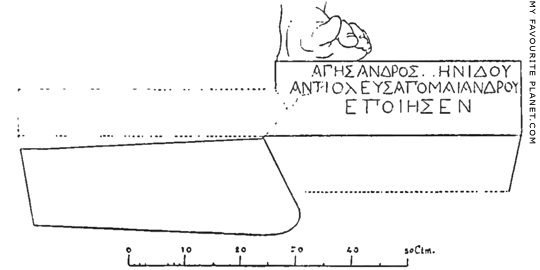
A reconstruction drawing of the "Venus de Milo" base, hypothetically
restoring the missing left foot of the statue and top left corner of the inscription.
The name of the artist has been restored as ΑΓΕΣΑΝΔΡΟΣ (Agesandros).
Source: Adolf Furtwängler, Meisterwerke der griechischen Plastik (part 1, text), Fig. 118,
page 608. Giesecke & Devrient, Leipzig / Berlin, 1893. At Heidelberg University Digital Library.
English version: Furtwängler, Adolf, Masterpieces of Greek sculpture, edited by Eugénie Sellers
(Strong), Fig. 160, page 372. William Heinemann, London, 1895. At the Internet Archive. |
| |
Alkamenes
Αλκαμένης (Latin, Alcamenes)
Worked in Athens, 2nd half of the 5th century BC
For further details see the Alkamenes page. |
|
|
| |
Alxenor
Ἀλξήνωρ (signature, Ἀλχσήνορ)
From Naxos, early 5th century BC
A grave stele of grey Boeotian marble, dated to around 490 BC, and found in Orchomenos, Boeotia, is signed at the bottom by Alxenor (see photo below). The low relief on the front of the stele is described as typical work of a Naxian workshop. National Archaeological Museum, Athens. Inv. No. 39. |
|
|
| |
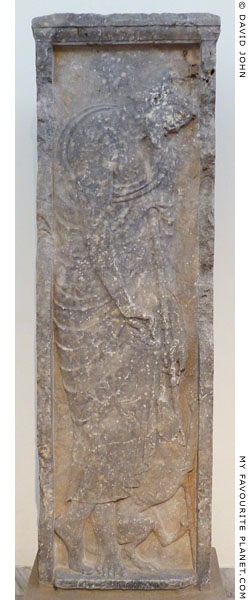
A marble grave stele from Orchomenos, Boeotia,
signed at the bottom by Alxenor in the Naxian alphabet:
Ἀλχσήνορ [ἐ]ποίησεν ό Νάχσιος ἀλλ’ ἐσίδεσ̣[θε]
"Alxenor of Naxos made this; just look!"
Inscription IG VII 3225 (also CEG 150)
at The Packard Humanities Institute.
Around 490 BC. Grey Boeotian marble.
Height 197 cm, width 61 - 59 cm, depth 18 cm.
National Archaeological Museum, Athens. Inv. No. 39. |
| |

A drawing of the signature of Alxenor inscribed at the bottom of the grave stele.
Source: Emanuel Loewy, Inschriften griechischer Bildhauer (Inscriptions of Greek sculptors),
No. 7, pages 10-11. B. G. Teubner, Leipzig 1885. At Heidelberg University Digital Library.
|
Most of the surface of the front of the stele is filled with a low relief depicting the full-length figure of an elderly bearded man, wearing a himation (cloak) and supporting himself on a walking stick or crutch. Between the forefinger and thumb of his right hand he holds a grasshopper (or cricket or locust) which he offers to his dog. He is thought to be the deceased honoured by the funerary monument, and the base of the stele (now missing) was probably inscribed with his name (as on the grave stele of Aristion by Aristokles).
The height of the stele given by different sources varies between 197 cm and 205 cm.
The stele was first reported by the Irish painter and traveller Edward Dodwell (1767-1832), who saw it in December 1801 in the churchyard of the village of Romaiko (Ρωμαίικο), on the river Kifissos, 4 km west of the site of ancient Orchomenos (Ὀρχομενός) and 2 km southwest of its acropolis. Dodwell was unable to decipher the Naxian script. He speculatively associated the insect held by the man on the stele with a historical or legendary plague of locusts.
"As the basis of the monument was under ground, I removed the earth, and discovered on it a few letters; which, from their imperfect state, it has been impossible to render intelligible."
"In the Athenian Acropolis there was anciently a statue of Apollo, named Parnopios, because he delivered the country from locusts [a bronze statue near the Parthenon, said to be by Pheidias, Pausanias, Description of Greece, Book 1, chapter 24, section 8]. Strabo [Geography, Book 13, chapter 1, section 64] says that the Oitaians honoured Hercules under the name of Kornopion, because he delivered them from locusts, which the Greeks generally called parnopes though the Oitaians called them kornopes. The monument of Romaiko may allude to this circumstance."
Edward Dodwell, A classical and topographical tour through Greece, during the years 1801, 1805, and 1806, Volume 1 (of 2), pages 242-243, with drawing. Rodwell and Martin, London, 1819. At the Internet Archive. |
|
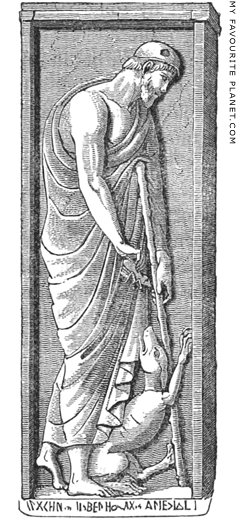
A drawing of the Alxenor stele
by Edward Dodwell. |
|
| |
Anaxagoras of Aegina
Ἀναξαγόρας
From Aegina, early 5th century BC
According to Pausanias, Anaxagoras made a bronze statue of Zeus at Olympia, commissioned by the Greek states which had united against the invasion of Xerxes I of Persia (480-479 BC), and fought at the Battle of Plataea in 479 BC against Xerxes' general Mardonius.
"As you pass by the entrance to the Council Chamber you see an image of Zeus standing with no inscription on it, and then on turning to the north another image of Zeus. This is turned towards the rising sun, and was dedicated by those Greeks who at Plataea fought against the Persians under Mardonius. On the right of the pedestal are inscribed the cities which took part in the engagement ..."
After listing the various cities, Pausanias continued:
"The image at Olympia dedicated by the Greeks was made by Anaxagoras of Aegina. The name of this artist is omitted by the historians of Plataea."
Pausanias, Description of Greece, Book 5, chapter 23, sections 1-3. |
|
|
|
| |
Antenor
Ἀντήνωρ
Working in Athens around 540-500 BC
Antenor made bronze statues of the Athenian "Tyrannicides" (Τυραννοκτόνοι) Harmodius and Aristogeiton (Ἁρμόδιος καὶ Ἀριστογείτων), two aristocrats who in 514 BC killed Hipparchos, brother of the Athenian tyrant Hippias, son and successor of the tyrant Peisistratos, and were then themselves killed.
The statue group, which stood in the Athenian Agora, was commissioned by the Athenians after Hippias had been driven out of the city with the help of the Spartans in 511/510 BC and the establishment of democracy. They were the first Greek statues known to depict real persons heroized by a recent historical event. Pliny the Elder thought that they may have been the first public statues of individual mortals. However, it is not known whether many earlier surviving Greek sculptures (particularly kouros and kore statues, see photos below) were meant to represent deities, mythological characters, generic figures or real individuals (for example the "Kleobis and Biton" statues).
"It was not the custom in former times to give the likeness of individuals, except of such as deserved to be held in lasting remembrance on account of some illustrious deed; in the first instance, for a victory at the sacred games, and more particularly the Olympic Games, where it was the usage for the victors always to have their statues consecrated. And if any one was so fortunate as to obtain the prize there three times, his statue was made with the exact resemblance of every individual limb; from which circumstance they were called "iconicae" [portrait statues].
I do not know whether the first public statues were not erected by the Athenians, and in honour of Harmodius and Aristogiton, who slew the tyrant; an event which took place in the same year in which the kings were expelled from Rome [510 BC]. This custom, from a most praiseworthy emulation, was afterwards adopted by all other nations; so that statues were erected as ornaments in the public places of municipal towns, and the memory of individuals was thus preserved, their various honours being inscribed on the pedestals, to be read there by posterity, and not on their tombs alone."
Pliny the Elder, Natural History, Book 34, chapter 9. At Perseus Digital Library.
Antenor's Tyrannicides were carried away to Persia by Xerxes I with other booty from his occupation of Athens in 480 BC. Around two centuries later they were returned by the Seleucid king Antiochus I Soter, but meanwhile two new statues had been made by Kritios and Nesiotes (Pausanias, Description of Greece, Book 1, chapter 8, section 5; also chapter 29, section 15). The Roman period statues of Harmodius and Aristogeiton now in the National Archaeological Museum, Naples, Inv. No. G 103 and G 104, are thought to be copies these later sculptures.
Pliny the Elder wrote that Praxtiles (4th century BC) also made bronze statues of Harmodius and Aristogeiton, although he incorrectly believed them to be the sculptures taken by Xerxes.
"He [Praxtiles] also executed a Stephanusa, a Spilumene, an Oenophorus, and two figures of Harmodius and Aristogiton, who slew the tyrants; which last, having been taken away from Greece by Xerxes, were restored to the Athenians on the conquest of Persia by Alexander the Great."
Natural History, Book 34, chapter 19. At Perseus Digital Library.
Later in the same chapter Pliny mentioned that a sculptor named Antignotus also made bronze statues of the Tyrannicides.
It has been suggested that the akroterion statue of winged Nike (515-505 BC) from the Archaic temple of Apollo in Delphi may be by Antenor. Delphi Archaeological Museum. Inv. No. 1872.
The so-called "Antenor's Kore" (or "Antenor Kore"), the largest of around 200 korai statues found on the Athens Acropolis, is thought to be a work of Antenor from an inscribed statue base on which it is now exhibited. Acropolis Museum. Inv. No. Acr. 681 (statue and base). Around 530-520 BC. Height of statue 255 cm (including plinth, 4 cm). Inscribed base height 30 cm, width 60.5 cm, depth 60.5 cm.
The feet of the statue and plinth were found in 1882 east of the Parthenon. The upper part and inscribed base were found on 5th and 6th February 1886 northwest of the Erechtheion. The connecting piece between feet and torso was found in 1887.
The fragmentary inscription on the base states that the statue was dedicated by Nearchos (perhaps a potter) and made by Antenor, son of Eumares (see photo below).
Νέαρχος ἀνέθεκεν̣ [ℎο κεραμε]-
ὺς ἔργον ἀπαρχὲν τ̣ἀθ[εναίαι].
Ἀντένορ ἐπ[οίεσεν ℎ]-
ο Εὐμάρος τ[ὸ ἄγαλμα].
Nearkhos [the potter ?] dedicated
this work from the first fruits to Athena.
Antenor, son of Eumares,
made the statue.
Inscription IG I³ 628 (Antony E. Raubitschek, Dedications from the Athenian Akropolis [DAA], No. 197).
Based on this inscription, it has been speculated that Antenor's father Eumares may have been the painter Eumarus of Athens mentioned by Pliny the Elder (Natural history, Book 35, chapter 34). Some scholars believe that Nearchos may be the Athenian potter and vase painter of the black figure style, active around 570-555 BC, who is known from surviving works, some of which he signed.
"Antenor's Kore" may have been made 510-500 BC, following the fall of Peisistratids, as part of a revival of the "broad and stocky" Attic type of sculpted figure, and a reaction to the tall, slim, more delicate Ionian statues (see Archemos of Chios) which had been preferred during the tyranny.
See: Guy Dickins, Catalogue of The Acropolis Museum, Volume I Archaic Sculpture, pages 19-24.
Cambridge University Press, 1912. At the Internet Archive. |
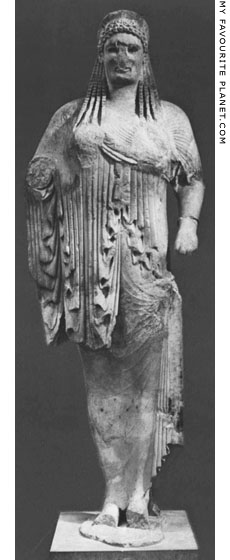
"Antenor's Kore".
Acropolis Museum, Athens.
Inv. No. Acr. 681. |
| |
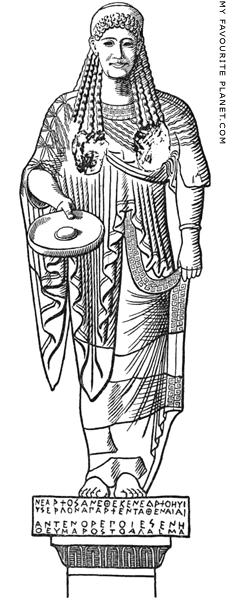
A reconstruction drawing of
"Antenor's Kore", showing the
figure holding a phiale in her
right hand, and standing on
the inscribed capital.
Image source:
Alexander Stuart Murray,
A history of Greek sculpture,
Volume 1, Fig. 41, page 158.
John Murray, London, 1890.
At the Internet Archive. |
| |
| |
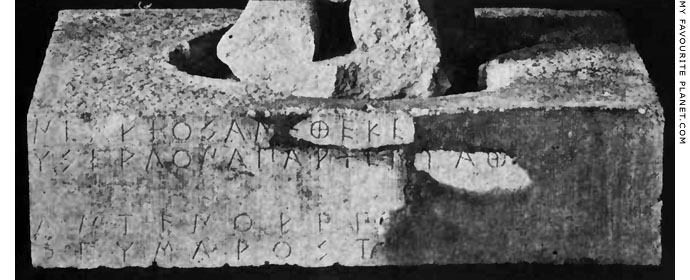
The statue base from the Athens Acropolis, dedicated by Nearkhos and signed by Antenor.
Source: Edmund von Mach, A handbook of Greek and Roman sculpture, Fig. 3.
Bureau of University Travel, Boston, 1914. |
| |
Antiphanes of Argos
Ἀντιφάνης ὁ Ἀργεῖος
From Argos, northeastern Peloponnese, late 5th century BC
He was a pupil of Periklytos, and teacher of Kleon.
Pausanias (Description of Greece, Book 10) mentioned several statues by Antiphanes at Delphi:
Elatos, Apheidas, Erasos, the Dioskouri and a bronze horse, "supposed to be the wooden horse of Troy". |
|
|
| |
Antonianos of Aphrodisias
Αντωνιανος ΑΦροδεισεις
Mid 2nd century AD
From Aphrodisias (Ἀφροδισιάς), Caria, western Anatolia (today near the modern village of Geyre, Aydın Province, Turkey).
See also Aristeas and Papias of Aphrodisias below.
Known from his signature inscribed on a marble relief depicting Antinous as Silvanus, 130-138 AD. Palazzo Massimo alle Terme, National Museum of Rome. Inv. No. 374071.
ANTωNIANOC AΦPOΔEICIEYC EΠOIEI
Antonianos of Aphrodisias made this.
Inscription SEG 43, 904.
See photos and details on the Antinous page. |
|
|
| |
Apelleas son of Kallikles
Ἀπελλέας Καλλικλέος, also Apelles (Ἀπελλῆς) or Apellas (Ἀπελλᾶς)
Late 5th - early 4th century BC
Son of Kallikles (Καλλικλῆς), who may have been the sculptor Kallikles, son of Theokosmos, from Megara (Μέγαρα), central Greece.
Part of an inscribed circular stone statue base found by German archaeologists in Olympia in 1879, with a dedicatory epigram for Kyniska and the signature of Apelleas son of Kallikles (see photo below) is thought to belong to a bronze statue group mentioned by Pausanias, although he referred to the artist as Apelles. He wrote that Kyniska (Κυνίσκα, born circa 440 BC), daughter of the Spartan king Archidamos II (Ἀρχίδαμος Β΄, ruled circa 476-427 BC), was the first woman to win Olympic victories.
"Archidamus left sons when he died, of whom Agis was the elder and inherited the throne instead of Agesilaus. Archidamus had also a daughter, whose name was Cynisca; she was exceedingly ambitious to succeed at the Olympic games, and was the first woman to breed horses and the first to win an Olympic victory. After Cynisca other women, especially women of Lacedaemon, have won Olympic victories, but none of them was more distinguished for their victories than she.
The Spartans seem to me to be of all men the least moved by poetry and the praise of poets. For with the exception of the epigram upon Cynisca, of uncertain authorship, and the still earlier one upon Pausanias that Simonides wrote on the tripod dedicated at Delphi, there is no poetic composition to commemorate the doings of the royal houses of the Lacedaemonians."
Pausanias, Description of Greece, Book 3, chapter 8, sections 1 and 2. At Perseus Digital Library.
The epigram is preserved in the Palatine Anthology (Anthologia Palatina, Book XIII, Epigram 16), and was used to help reconstruct the inscription on the statue base.
Kyniska's brother Agesilaos was later to become King Agesilaos II of Sparta (Ἀγησίλαος Β΄, ruled circa 398-360 BC), and her victories may have been during his reign, perhaps in the 96th and 97th Olympics (396 and 392 BC). In his short biography of the king, Xenophon of Athens (Ξενοφῶν, circa 430-354 BC), claimed it was Agesilaos who encouraged his sister to breed chariot horses:
"And what a fine trait this was in him [Agesilaos], and betokening how lofty a sentiment, that, being content to adorn his own house with works and possessions suited to a man, and being devoted to the breeding of dogs and horses in large numbers for the chase and warfare, he persuaded his sister Cynisca to rear chariot horses, and thus by her victory showed that to keep a stud of that sort, however much it might be a mark of wealth, was hardly a proof of manly virtue."
Xenophon, Agesilaus. Translated by Henry Graham Dakyns. The Works of Xenophon, Volume 2, chapter IX. At Wikisource.
Later, Pausanias described the statue group in Olympia and said that it was made by Apelles.
"As for Cynisca, daughter of Archidamus, her ancestry and Olympic victories, I have given an account thereof in my history of the Lacedaemonian kings [Book 3]. By the side of the statue of Troilus at Olympia has been made a basement of stone, whereon are a chariot and horses, a charioteer, and a statue of Cynisca herself, made by Apelles; there are also inscriptions [ἐπιγράμματα, epigrams] relating to Cynisca."
Pausanias, Description of Greece, Book 6, chapter 1, section 6. At Perseus Digital Library.
Only around a third of the circular base has been found. Its original diameter is estimated to have been around 1 metre, and far too small for a statue of a chariot. On its top, along with the inscription, is the trace of a footprint. It is thus thought that this may have been the base of the statue of Kyniska herself.
Earlier in his guided walk around the Altis, the Sanctuary of Zeus in Olympia, he had noted reduced-sized bronze horses, a replica of Kyniska's victory monument, in the pronaos (front porch) of the Temple of Zeus:
"The offerings inside, or in the fore-temple include: a throne of Arimnestus, king of Etruria, who was the first foreigner to present an offering to the Olympic Zeus, and bronze horses of Cynisca, tokens of an Olympic victory. These are not as large as real horses, and stand in the fore-temple on the right as you enter. There is also a tripod, plated with bronze, upon which, before the table was made, were displayed the crowns for the victors."
Pausanias, Description of Greece, Book 5, chapter 12, section 5. At Perseus Digital Library.
Pausanias did not write that these horses had beeen made by the same artist. However, on 28 November 1876 part of another inscription with the signature of Apelleas was found on a fragment of a tapering rectangular white marble plinth in the pronaos of the Temple of Zeus. The plinth, dated to the first half of the 4th century BC, and estimated to have originally been 100 cm high, 42 cm wide and 46-47 cm deep, is thought to have been the base for the bronze horses of Kyniska.
[Ἀπε]λλέας Καλλικλέος
[ἐπό]ησε.
[Ape]lleas son of Kallikles
made it
Inscription IvO 634.
IvO = Inschriften von Olympia: Wilhelm Dittenberger and Karl Purgold, Olympia, Textband 5: Die Inschriften von Olympia, Numbers 160 and 634. A. Ascher & Co., Berlin, 1896. At Heidelberg University Digital Library.
Apelleas may have been the Apellas mentioned by Pliny the Elder as a sculptor in bronze who made statues of worshipping females, among a number of artists who achieved celebrity, "but none of whom have produced any first-rate works".
"Apellas has left us some figures of females in the act of adoration."
Natural History, Book 34, chapter 19. At Perseus Digital Library.
As with many Greek artworks mentioned by Pliny, Kyniska's victory monument may have been taken to Rome. It has been suggested that her statue, like those of other victors in Olympia, showed her as an adorant. In fact, immediately after Pausanias told us that Kyniska's statue was made by Apelles, he mentioned other statues of Lacedaemonians who had won victories in chariot races, including Anaxander (Ἀνάξανδρος), who "is represented in an attitude of prayer to the god [Zeus]." (Book 6, chapter 1, section 7)
Although neither Pliny nor Pausanias tell us about the family or place of origin of Apellas / Apelles, from the fortunate find of the statue base with the dedication to Kyniska and the signature of "Apelleas son of Kallikles", added to the other information provided by Pausanias concerning Theokosmos of Megara and his son Kallikles, it appears that all three were members of the same family of artists. |
|
|
| |
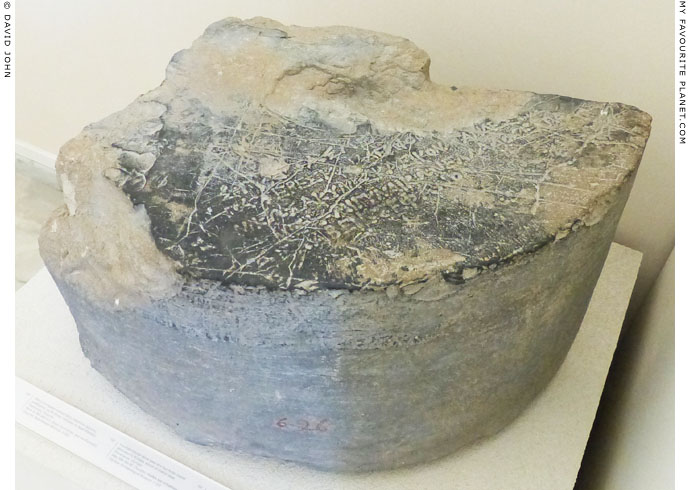
Fragment of an inscribed circular black limestone base for part of a bronze
statue group by Apelleas son of Kallikles to commemorate Olympic race
victories by horses and chariots owned by the Spartan princess Kyniska.
After 390-380 BC. Found on 11 June 1879 in the north part of the Prytaneion,
Olympia. Height 49 cm, thickness 47 cm. Original diameter circa 100 cm.
On top:
Σπάρτας μὲν [βασιλῆες ἐμοὶ]
πατέρες καὶ ἀδελφοί, ἅ[ρματι δ’ ὠκυπόδων ἵππων]
νικῶσα Κυνίσκα εἰκόνα τάνδ’ ἔστασε· μόν[αν]
δ’ ἐμέ φαμι γυναικῶν Ἑλλάδος ἐκ πάσας τό[ν]-
δε λαβε͂ν στέφανον.
On the front side:
Ἀπελλέας Καλλικλέος ἐπόησε.
My fathers and brothers are kings of Sparta.
I, Kyniska, victorious with a chariot of swift-footed horses,
have set up this statue. I declare myself the only woman
in all Hellas to have ever won this crown.
Apelleas son of Kallikles made it.
Inscription IvO 160.
Emanuel Loewy, Inschriften griechischer Bildhauer, No. 99.
Olympia Archaeological Museum. Inv. No. Λ 529.
Currently exhibited in the Museum of the History
of the Ancient Olympic Games, Olympia. |
| |
Apollonios, son of Archias the Athenian
Απολλωνιος Αρχιου Αθηναιος
Working around the time of the reign of Augustus (27 BC - 14 AD)
Apollonios is known only from his signature on the front of a bronze herm with a head of the Doyrphoros type:
Ἀπολλώνιος Ἀρχίου Ἀθηναῖος ἐπόησε.
Apollonios son of Archias the Athenian made me.
Inscription IG XIV 712.
Found in the Villa of the Papyri, Herculaneum. National Archaeological Museum, Naples. Inv. No. 4885. See photo and further details under Polykleitos the Elder. |
|
|
| |
Apollonios and Tauriskos (of Tralles)
Απολλώνιος και Ταυρίσκος (Latin, Apollonius et Tauriscus)
Brothers, probably from Tralles (Τράλλεις), Caria (today Aydın, Turkey), 2nd century BC.
Sons of Artemidorus (Ἀρτεμίδωρος);
pupils and perhaps adoptive sons of Menekrates.
Apollonios and Tauriskos are among the sculptors whose works Pliny the Elder wrote were displayed in the memorial buildings of Asinius Pollio (75 BC - 4 AD) in Rome.
"Asinius Pollio, a man of a warm and ardent temperament, was determined that the buildings which he erected as memorials of himself should be made as attractive as possible; for here we see groups representing, Nymphs carried off by Centaurs, a work of Arcesilas: the Thespiades, by Cleomenes: Oceanus and Jupiter, by Heniochus: the Appiades, by Stephanus: Hermerotes, by Tauriscus, not the chaser in silver, already mentioned, but a native of Tralles: a Jupiter Hospitalis by Papylus, a pupil of Praxiteles: Zethus and Amphion, with Dirce, the Bull, and the halter, all sculptured from a single block of marble, the work of Apollonius and Tauriscus, and brought to Rome from Rhodes. These two artists made it a sort of rivalry as to their parentage, for they declared that, although Artemidorus was their natural progenitor, Menecrates would appear to have been their father."
Pliny the Elder, Natural History, Book 36, chapter 4. At Perseus Digital Library.
It is not clear if the "Tauriscus ... a native of Tralles" who made the Hermerotes is the same person as the brother of Apollonius. Some scholars, believing them to be the same, refer to the brothers as Apollonius and Tauriscus of Tralles.
From what Pliny wrote, their father was Artemidorus (the Perseus translation has "Apollodorus" for the name of the father, but the Latin text and other translations have "Artemidorus"). Menekrates (also referred to as Menekrates of Rhodes) appears to have been their teacher and/or adoptive father.
It is thought that the much-restored marble statue group known as the "Farnese Bull" (Toro Farnese) may be a 3rd century AD copy of the "Zethus and Amphion, with Dirce, the Bull, and the halter" by Apollonius and Tauriscus, probably made in the late 2nd or early 1st century BC. The largest single classical sculpture yet discovered, it was unearthed in August 1545 in the gymnasium of the Baths of Caracalla, Rome, during excavations commissioned by Pope Paul III (Alessandro Farnese, pope 1534-1549). Height 370 cm. The group depicts the myth of the brothers Zethus and Amphion binding Dirce, queen of Thebes, to an enraged bull to avenge their mother, Antiope. In 1546 it was installed in the Palazzo Farnese, Rome. In 1788 it was taken to Naples with other objects from the Farnese Collection, and is now in the National Archaeological Museum, Naples, Inv. No. 6002. |
|
|
| |
Archelaos of Priene
Ἀρχέλαος Πριηνεὐς
Son of Apollonios of Priene, Ionia
3rd or 2nd century BC
The Apotheosis of Homer, a Hellenistic marble relief, also known as "the Relief of Archelaos", signed by Archelaos, son of Apollonios of Priene.
Ἀρχέλαος Ἀπολλωνίου
ἐποίησε Πριηνεύς
Archelaos, son of Apollonios,
made it, of Priene
Inscription IG XIV 1295
The relief, carved on a 117 cm high slab of white Parian marble, is thought to have to have been made in Alexandria, Egypt, 3rd or 2nd century BC. Parian marble. Discovered near Rome in the 17th century, it is now in the British Museum, London. Inv. No. GR 1819.8-12.1. Sculpture 2191. |
|
|
| |
Archermos of Chios
Άρχερμος (Latin, Archermus)
Mid-late 6th century BC
Pliny the Elder (Natural History, Book 36, chapter 4) wrote that Archermos belonged to a family of sculptors from Chios: his grandfather Melas of Chios, his father Mikkiades, and his sons, Bupalus and Athenis. He placed Melas even earlier than Dipoenos and Skyllis (early 6th century BC), "the first artists who distinguished themselves in the sculpture of marble", making him one of the earliest known Greek sculptors.
"Before these artists [Dipoenos and Skyllis] were in existence, there had already appeared Melas, a sculptor of the isle of Chios; and, in succession to him, his son Micciades, and his grandson Archermus; whose sons, Bupalus and Athenis, afterwards attained the highest eminence in the art. These last were contemporaries of the poet Hipponax, who, it is well known, lived in the sixtieth Olympiad [540 BC]. Now, if a person only reckons, going upwards from their time to that of their great-grandfather, he will find that the art of sculpture must have necessarily originated about the commencement of the era of the Olympiads."
Concerning Bupalus and Athenis, Pliny continued:
"Hipponax being a man notorious for his ugliness, the two artists, by way of joke, exhibited a statue of him for the ridicule of the public. Indignant at this, the poet emptied upon them all the bitterness of his verses; to such an extent indeed, that, as some believe, they were driven to hang themselves in despair.
This, however, is not the fact; for, at a later period, these artists executed a number of statues in the neighbouring islands; at Delos for example, with an inscription subjoined to the effect, that Chios was rendered famous not only by its vines but by the works of the sons of Archermus as well.
The people of Lasos still show a Diana [Artemis] that was made by them; and we find mention also made of a Diana at Chios, the work of their hands: it is erected on an elevated spot, and the features appear stern to a person as he enters, and joyous as he departs.
At Rome, there are some statues by these artists on the summit of the Temple of the Palatine Apollo, and, indeed, in most of the buildings that were erected by the late Emperor Augustus. At Delos and in the Isle of Lesbos there were formerly some sculptures by their father to be seen."
Pliny, Natural History, Book 36, chapter 4.
At Perseus Digital Library.
Bupalos (Βούπαλος) made the cult statue of Tyche (Τύχη; Latin, Fortuna) for the city of Smyrna, on the Ionian coast of Anatolia, near Chios.
"Bupalos a skilful temple-architect and carver of images, who made the statue of Fortune [Tyche] at Smyrna, was the first whom we know to have represented her with the heavenly sphere [the headdress] upon her head and carrying in one hand the horn of Amaltheia [the cornucopia], as the Greeks call it, representing her functions to this extent. The poems of Pindar later contained references to Fortune, and it is he who called her Supporter of the City."
Pausanias, Description of Greece, Book 4, chapter 30, section 6.
Bupalos also made a group of the Graces (Χάριτες, Charites) in gold for Smyrna, as well as another group of the Graces which in Pausanias' time stood in Pergamon.
"Who it was who first represented the Graces naked, whether in sculpture or in painting, I could not discover. During the earlier period, certainly, sculptors and painters alike represented them draped. At Smyrna, for instance, in the sanctuary of the Nemeses, above the images have been dedicated Graces of gold, the work of Bupalus; and in the Music Hall [Odeion] in the same city there is a portrait of a Grace, painted by Apelles. At Pergamus likewise, in the chamber of Attalus, are other images of Graces made by Bupalus. And near what is called the Pythium there is a portrait of Graces, painted by Pythagoras the Parian. Socrates too, son of Sophroniscus, made images of Graces for the Athenians, which are before the entrance to the Acropolis. All these are alike draped; but later artists, I do not know the reason, have changed the way of portraying them. Certainly today sculptors and painters represent Graces naked."
Pausanias, Description of Greece, Book 9, chapter 35, section 6. |
|
Archaic marble statue of Nike from Delos. The earliest known free-standing statue of a winged Nike, probably by Archermos of Chios, circa 550 BC. Found on Delos in 1877.
National Archaeological Museum, Athens.
Inv. No. 21.
The Scholia (commentary) of Aristophanes' Birds mentions Archermos, artist, father of Bupalos and Athenis (or Athenidos), said to have been the first to represent Victory with wings:
"Only more recently have Nike and Eros acquired wings. For some say that it was Archennos [sic] the father of Boupalos and Athenis, others that it was Aglaophon the Thasian painter who made Nike winged, as Karystios of Pergamon relates."
There are varying translations of the Scholia. "Archennos" is thought to have been an error or misreading by those who copied the manuscripts.
See: John Williams White, The scholia on the Aves of Aristophanes, 574, pages 120 and 368. Ginn and Company, Boston and London, 1914. At the Internet Archive.
An inscribed statue base signed by Archermos and Mikkiades (perhaps Archermos' father), found in two fragments in 1880-1881 near to the findspot of the Nike, was thought to belong to the statue (see photo on the Nike page), leading archaeologists to believe they had discovered the first winged Nike by Archermos. However, the base was later thought to have supported a sphinx. The fragmentary inscription has been reconstructed and translated in a number of ways.
Μ̣ικκι̣ά̣[δης τόδ’ ἄγ]α̣λ̣μ̣α καλὸν μ̣’ [ἀνέθηκεν καὶ υἱὸς]
Ἄ̣ρχερμ̣ος θ[υσ]ί̣η̣σιν ℎ(ε)κήβο[λον αὖθ’ ἱλάσασθαι]
οἱ Χῖοι Μέλ̣α̣ν̣ος πατρώιον ἄσ[τυ λιπόντες]
Inscription SEG 19:510.
Inscription ID 9 (also SEG 19:510 and SEG 33:633).
"Farshooter [Apollo, receive this] fine figure [... worked by] the skills of Archermos, from the Chian Mikkiades ... the paternal city of Melas"
John Boardman, Greek art, page 91. Thames and Hudson, London, 2012 (4th edition).
It has been suggested that Pliny's source of information on Archermos may have been familiar with this (or a similar) inscription, but had incorrectly interpreted the name of Melas, the mythical founder of Chios, as the artist's grandfather. It has also been suggested that Mikkiades and Archermos may have been the dedicators rather than the sculptors of the statue.
Another signature of Archermos on a marble column, found on the Athens Acropolis, has been associated with the "Chiotissa" kore statue also found on the Acropolis (see photos below).
The head of a Caryatid in the Ionic style discovered at Delphi, dated around 530 BC, is thought to be a work of the school of Chios and has been associated with the Delian Nike statue (see photo below). Delphi Archaeological Museum. Inv. No. 1203.
| |
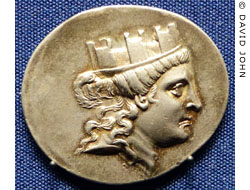
A silver tetradrachm coin of Smyrna,
Ionia (today Izmir, Turkey), showing
the goddess Tyche wearing a mural
crown. 180-140 BC.
Münzkabinett, Staatliche
Kunstsammlungen, Dresden. |
|
|
|
| |
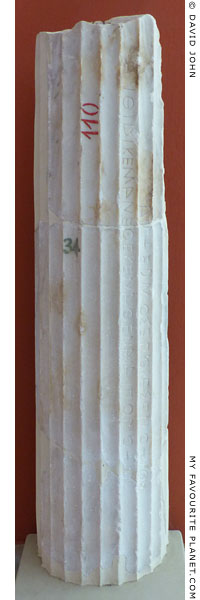
Part of a fluted marble column which probably
supported a statue, inscribed in two flutes
with the signature of the sculptor Archemos
of Chios and a dedication by a woman named
Iphidike to Athena Poliouchos (Πολιοῦχος,
Protector of the City).
Around 510-500 BC. Three fragments found
separately on the Athens Acropolis in 1840,
1886 and 1899. Grey marble. Height 91.5 cm,
diameter 25 cm. 26 flutes; width of flute 3.2 cm.
Ἄρχερμος ἐποίε̄σεν ὁ Χῖος.
Ἰφιδίκε̄ μ᾽ ἀνέθε̄κεν Ἀθε̄ναίαι πολιό̄χο̄ι.
Archermos the Chian made me.
Iphidike dedicated me to Athena Poliouchos.
Inscription IG I³ 683 (= CEG 198; Antony E.
Raubitschek, Dedications from the Athenian
Akropolis [DAA], No. 3).
Epigraphical Museum, Athens.
Inv. No. EM 6241. |
|
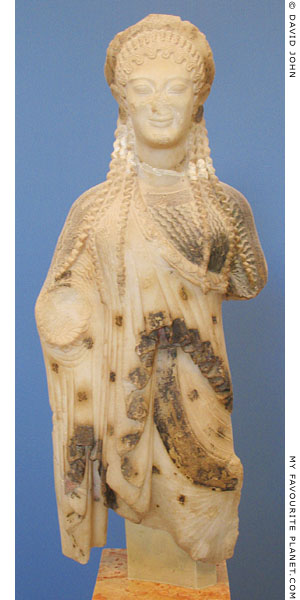
The upper part of a marble kore statue from
the Athens Acropolis, nicknamed "Chiotissa"
(χιώτισσα, Chian girl) because of its Ionic
features and its association with the statue
base signed by Archemos of Chios.
Around 520-510 BC. The head found in
1886 east of the Parthenon. The body
found in 1888 south of the Parthenon.
Island (Parian?) marble. Height 55.5 cm.
One of several korai excavated on the
Athens Acropolis, believed to have
been buried deliberately following
the destruction of monuments there
during the Persian invasion in 480 BC.
Acropolis Museum, Athens. Inv. No. 675. |
|
| |
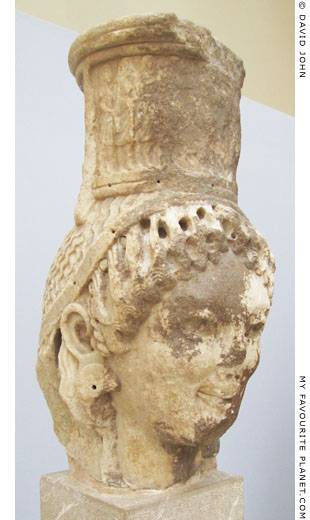
The marble head of an Archaic caryatid from Delphi, formerly believed to be from the
Knidian Treasury there. Around the side
of her polos (or kalathos) is a now damaged
relief depicting Apollo standing and playing
a lyre, flanked by four Nymphs, three Graces
and Hermes, who is playing the syrinx.
Ionic style, probably by the school of Chios,
around 530 BC. Parian marble. Height 66 cm.
Delphi Archaeological Museum. Inv. No. 1203.
See also:
a caryatid of the Siphnian Treasury, Delphi. |
|
|
|
| |
Aristeas and Papias of Aphrodisias
Ἀριστέας και Παπίας
Early - mid 2nd century AD. From Aphrodisias (Ἀφροδισιάς), Caria, western Anatolia (today near the modern village of Geyre, Aydın Province, Turkey).
Aristeas and Papias are known only from their signatures on the plinths of the "Furietti Centaurs", two marble statues of Centaurs, one young and the other old (see photos below).
ΑΡΙCΤΕΑC ΚΑΙ ΠΑΠΙΑC ΑΦΡΟΔΕΙCΕΙC
Aristeas and Papias of Aphrodisias
Inscription IG XIV 1237.
The statues, made of dark grey bigio morato marble, were found in December 1736 in Hadrian's Villa, Tivoli, near Rome, during excavations by Giuseppe Alessandro Furietti (1685-1764). Furietti is said to have refused to give them to Pope Benedict XIV, for which he was denied the post of cardinal. He was eventually created cardinal priest in 1759 by Pope Clement XIII. After his death his heirs sold the Centaurs and the "Furietti mosaic" of drinking doves for 14,000 scudi to Clement who gave them to the Capitoline Museum, Rome, in 1765. They are now exhibited in the Salone (Great Hall), Palazzo Nuovo, Capitoline Museums.
Because of their findspot, they have been dated to the reign of Emperor Hadrian (117-138 AD). They may be copies of Hellenistic originals of the 3rd - 2nd century BC, and therefore Aristeas and Papias may have been Greek copyists, although it is not known whether they worked in Italy or Asia Minor. It has beeen questioned whether the signatures refer to the makers of these two statues or the original creators of the type (see also the discussion concerning the signature of Dioskourides of Samos).
The younger Centaur (Inv. No. MC 656) has been described as intoxicated by love, while the older figure (MC 658) is tormented by love. This is perhaps a reference to a literary conceit of Hellenistic or Roman poetry, rather than more ancient mythology. A white marble statue very similar to the older Centaur, found in Rome in the 17th century and now in the Louvre (Inv. No. Ma 562; height 147 cm), shows the bearded figure being tormented by a winged infant Eros riding on his back. The statue, dated to the 1st or 2nd century AD, may also been one of a pair, and it is thought each of the "Furietti Centaurs" originally also carried an Eros on his back.
Although some older modern sources state that Aristeas and Papias were from Aphrodisium (Ἀφροδίσιον, Aphrodision) in Cyprus, most more recent sources, including the Capitoline Museums, agree that they were from Aphrodisias, Caria. Recent scientific studies indicate that the dark grey and black types of marble used in ancient sculpture and architecture, such as bigio morato and bigio antico, came from this area of western Anatolia (Asia Minor) and neighbouring islands such as Lesbos and Chios.
See, for example: D. Attanasio, M. Bruno, W. Prochaska, A. B. Yavuz, Ancient 'black' decorative stones and the Ephesian origin of sculptural bigio antico. Archaeometry 59, 5 (2017), pages 794-814. PDF available at Wiley Online Library. |
|
|
| |
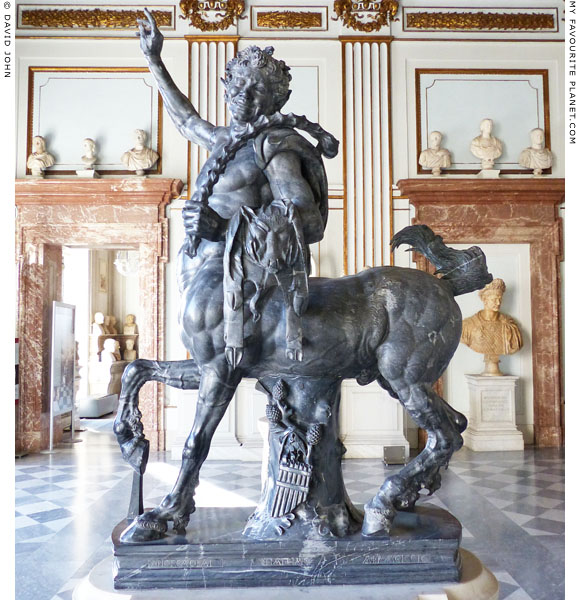
A dark grey marble statue of a young Satyr, signed along the front (or right side) of
the plinth by Aristeas and Papias of Aphrodisias, ΑΡΙCΤΕΑC ΚΑΙ ΠΑΠΙΑC ΑΦΡΟΔΕΙCΕΙC.
117-138 AD, perhaps after a 3rd - 2nd century BC Greek original. Found in 1736
in Hadrian's Villa, Tivoli. Bigio morato marble. Height 156 cm, length 130 cm.
Salone (Great Hall), Palazzo Nuovo, Capitoline Museums, Rome. Inv. No. MC 656.
Donated to the museum by Pope Clement XIII in 1765.
|
The Centaurs, particularly the younger of the two, appear more like Satyrs with their wild nudity and pointed ears. The "bucolic" objects on the statues, the club-like lagobolon (hunting stick, see Pan), animal skins, pine cones, syrinx (Pan pipes) and cymbals, were usually associated in ancient Greek art with Dionysus and his thiasos (entourage). Centaurs began appearing in Dionysian iconography during the Roman Imperial period in scenes depicting the Triumph of Dionysus. The horse parts of the figures are proportionately smaller than the human parts.
In terms of style and use of unusual, expensive marble, the Centaur pair are similar to the statue of a "Faun" (Satyr) in marmo rosso antico (red marble), which was also found in 1736 in Hadrian's Villa at Tivoli, and now stands in the Sala del Fauno (Hall of the Faun), the next room in the Palazzo Nuovo. See the photo on the Dionysus page. |
|
|
| |
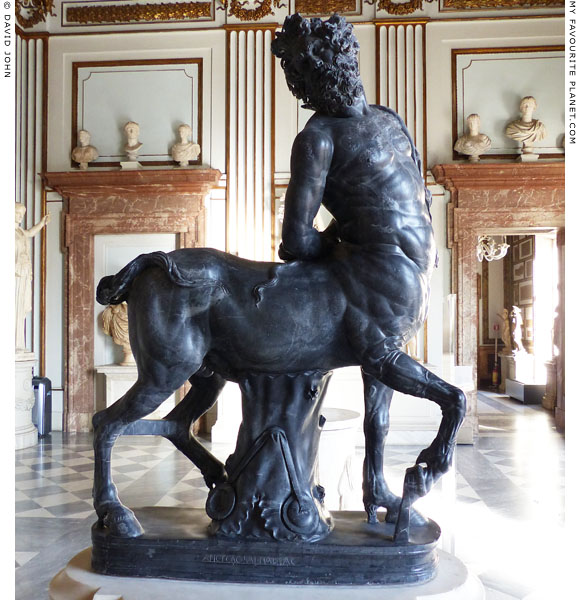
A dark grey marble statue of an old Centaur, signed on the front (or left side)
of the plinth by Aristeas and Papias of Aphrodisias (see photo below).
117-138 AD, perhaps after a 3rd - 2nd century BC Greek original. Found in 1736 in
Hadrian's Villa, Tivoli. Bigio morato marble. Height 134 cm (plinth 10 cm), length 140 cm.
Salone, Palazzo Nuovo, Capitoline Museums, Rome. Inv. No. MC 658.
Donated to the museum by Pope Clement XIII in 1765. |
| |
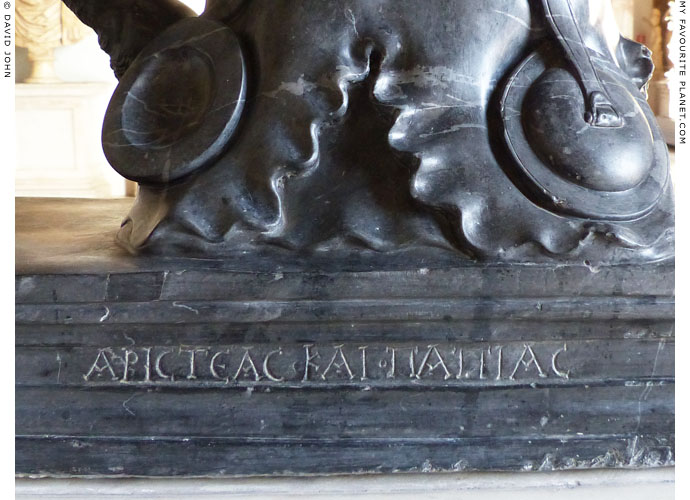
The signature of Aristeas and Papias, ΑΡΙCΤΕΑC ΚΑΙ ΠΑΠΙΑC, on the front (or left
side) of the plinth of the marble statue of the old Centaur. The word ΑΦΡΟΔΕΙCΕΙC
(Aphrodeiseis, of Aphrodisias) is inscribed on the right side (or front) of the base. |
| |
Aristion of Paros
Αριστίων Πάριός
Working in Athens around 540-525 BC
See the Aristion of Paros page. |
|
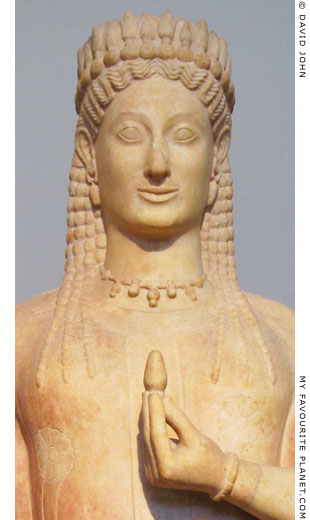
Detail of the Phrasikleia kore
statue by Aristion of Paros. |
|
| |
Aristokles
Ἀριστοκλε͂ς or Ἀριστοκλῆς (Aristocles)
Late 6th century BC.
Working in Attica (?)
Nothing is known about his life, and only his name is known from signatures on surviving parts of funerary monuments from Attica. These may be have been works by more than one sculptor of this name.
Pausanias mentioned works by a sculptor or sculptors called Aristokles, thought to have been working in the 6th - 5th centuries BC:
Aristokles of Kydonia (Aristokles the Elder, perhaps around 600-568 BC);
Aristokles of Sikyon (Aristokles the Younger), perhaps the grandson of the former, and mentioned by Pausanias as the brother of Kanachos of Sikyon (the Elder), thought to have been working around the same time, around 540-508 BC.
Aristokles, son of Kleoitas
Aristokles was not an uncommon name, and no connection has been established between these artists and the sculptor (or sculptors) working in Athens around this time. |
|
A grave stele of Pentelic marble, known as the "Stele of Aristion" and dated to 510 BC, found in Velanideza, Attica, is signed at the bottom "work of Aristokles" (ἔργον Ἀριστοκλέος, ergon Aristokleos). The base of the stele is also inscribed with the name of the deceased man Aristion.
The stele itself has a finely sculpted and painted relief showing the full-length figure of a hoplite wearing a helmet, chitoniskos, cuirass and greaves, and holding a spear in his left hand.
National Archaeological Museum, Athens.
Inv. No. 29.
See photos on the Aristokles page.
Aristokles' signature has been found on parts of three funerary monuments, all dated around 525-500 BC, from Kerameikos, Athens, now in the Kerameikos Archaeological Museum:
The base of a funerary statue, possibly of a horseman, for Xenophantos son of Sophilos.
Inv. No. I 389.
Base for a marble kouros statue for a Carian. Inv. No. I 190.
Fragment of a funerary stele for a woman.
Inv. No. P 1265.
See the Aristokles page. |
|
|
| |
Aristokles of Kydonia
Ἀριστοκλῆς Κυδωνιάτης (Latin, Aristocles)
Also referred to as Aristokles the Elder
From Kydonia (Κυδωνία, today Chania), on the north coast of Crete.
Perhaps working around 600-568 BC, and perhaps the grandfather of Aristokles of Sikyon
Pausanias mentioned a statue group by Aristokles of Kydonia in Olympia, depicting Herakles fighting the Amazon queen Hippolyta. It stood next to a bronze statue of Herakles by Onatas of Aegina, dedicated by the Achaeans (see Onatas).
"Not far from the offering of the Achaeans there is also a Heracles fighting with the Amazon, a woman on horseback, for her girdle. It was dedicated by Evagoras, a Zanclaean by descent, and made by Aristocles of Cydonia. Aristocles should be included amongst the most ancient sculptors, and though his date is uncertain, he was clearly born before Zancle took its present name of Messene."
Pausanias, Description of Greece, Book 5, chapter 25, section 11.
The ancient city of Zankle (Ζάγκλη), at the northeast tip of Sicily, was renamed Messine (Μεσσήνη; today Messina) around 494 BC (Thucydides, Peloponnesian War, Book 6, chapter 4).
It is thought that a fragment of Parian marble (height 10.5 - 12.5 cm, width 22.5 cm, depth 9 cm) found in 1876 in the temple of Zeus in Olympia, may be part of the pedestal of the statue group described by Pausanias. It is inscribed in large Archaic letters that may form part of the word [Κυ]δωνιατας (Kydonian).
See:
Wilhelm Dittenberger and Karl Purgold (editors),
Olympia: die Ergebnisse der von dem Deutschen Reich veranstalteten Ausgrabung, Textband 5: Die Inschriften von Olympia, No. 836. A. Ascher & Co., Berlin, 1896. At Heidelberg University Digital Library.
Archäologische Zeitung, Jahrgang 40 (1882), page 88, No. 426. Deutsches Archäologisches Institut. Georg Reimer, Berlin, 1882.
Hermann Roehl, Inscriptiones Graecae Antiquissimae (I.G.A.), No. 577, page 166. Georg Reimer, Berlin, 1882. |
|
|
| |
Aristokles of Sikyon
Ἀριστοκλῆς Σικυώνιος (Latin, Aristocles)
Also referred to as Aristokles the Younger
From Sikyon, northern Peloponnese, working mid-late 5th century BC
Perhaps the grandson of Aristokles of Kydonia
He was mentioned by Pausanias as the brother of Kanachos of Sikyon (the Elder), thought to have been working around the same time (around 540-508 BC), and teacher of Synnoon of Aegina (Συννοῶν Αἰγινήτης):
"Theognetus of Aegina succeeded in winning the crown for the boys' wrestling-match, and Ptolichus of Aegina made his statue. Ptolichus was a pupil of his father Synnoon, and he of Aristocles the Sicyonian, a brother of Canachus and almost as famous an artist."
Pausanias, Description of Greece, Book 6, chapter 9, section 1. At Perseus Digital Library.
He is also mentioned in connection with a statue in Olympia by Pantias of Chios (son and pupil of Sostratos of Chios, Book 6, chapter 9, section 3), as a link in a chain of seven teachers and pupils in which Aristokles of Sikyon was the first and Pantias the last.
"After Hysmon comes the statue of a boy wrestler from Heraea in Arcadia, Nicostratus the son of Xenocleides. Pantias was the artist, and if you count the teachers you will find five between him and Aristocles of Sicyon."
Pausanias, Description of Greece, Book 6, chapter 3, section 11. At Perseus Digital Library.
Five members of this succession and their order can be found in Pausanias, although the pupil of Ptolichos and the teacher of Sostratos of Chios are unknown:
1. Aristokles of Sikyon
2. Synnoon of Aegina (Συννοῶν Αἰγινήτης), father and teacher of
3. Ptolichos of Aegina (Πτόλιχος Αἰγινήτης; also mentioned in Book 6, chapter 10, section 9)
4. unknown
5. unknown
6. Sostratos of Chios (Σώστρατος Χῖος), father and teacher of (Book 6, chapter 9, section 3)
7. Pantias of Chios (Παντίας Χῖος; also mentioned in Book 6, chapter 14, section 12)
Attempts have been made to complete this list by suggesting artists including Aristokles of Kydonia, Kleoitas and his son Aristokles.
Statues of three Muses by Aristokles, Kanachos and Ageladas were described in an epigram by the Greek poet Antipater of Sidon (Ἀντίπατρος ὁ Σιδώνιος) in the 2nd century BC (see Ageladas above). |
|
|
| |
Aristokles, son of Kleoitas
Ἀριστοκλῆς (Latin, Aristocles)
Perhaps working in the early-mid 5th century BC
He was the son and pupil of Kleoitas (Κλεοίτας, perhaps early 5th century BC). His son, also named Kleoitas, appears to have been an artist as well as an inventor or engineer, and devised the starting mechanism for the horse race at the Olympic Games:
"It was Cleoetas who originally devised the method of starting, and he appears to have been proud of the discovery, as on the statue at Athens he wrote the inscription:
'Who first invented the method of starting the horses at Olympia,
He made me, Cleoetas the son of Aristocles.'
It is said that after Cleoetas some further device was added to the mechanism by Aristeides."
Pausanias, Description of Greece, Book 6, chapter 20, section 14. At Perseus Digital Library.
Pausanias mentioned a statuette of Zeus and a statue group of Zeus and Ganymede by Aristokles, son of Kleoetas, in the sanctuary of Zeus in Olympia:
"Beside the Pelopium is a pillar of no great height with a small image of Zeus on it; one hand is outstretched. Opposite this are other offerings in a row, and likewise images of Zeus and Ganymedes. Homer's poem tells how Ganymedes was carried off by the gods to be wine-bearer to Zeus, and how horses were given to Tros in exchange for him [The Iliad, Book 5, line 265 onwards, and Book 20, line 231 onwards]. This offering was dedicated by the Thessalian Gnathis and made by Aristocles, pupil and son of Cleoetas."
Pausanias, Description of Greece, Book 5, chapter 24, section 5. At Perseus Digital Library.
On the Athenian Acropolis, Pausanias noted a statue by Kleoitas:
"Those who prefer artistic workmanship to mere antiquity may look at the following: a man wearing a helmet, by Cleoetas, whose nails the artist has made of silver, and an image of Earth beseeching Zeus to rain upon her; perhaps the Athenians themselves needed showers, or maybe all the Greeks had been plagued with a drought."
Pausanias, Description of Greece, Book 1, chapter 24, section 3. At Perseus Digital Library.
In the English translation, the name Kleoitas is rendered as "Cleoetas", but in the Greek text it appears as Κλεοίτας (Kleoitas). See Book 1, Book 5 and Book 6 in Greek at Perseus Digital Library. |
|
|
| |
Askaros of Thebes
Ἄσκαρος (Latin, Ascarus)
Late 6th - early 5th century BC
Known only from a single mention by Pausanias (Book 5, chapter 24, section 1), who named him as a pupil of Kanachos of Sikyon. It has been argued that the text is corrupt, and that he may have been a pupil of Aristokles.
Pausanias wrote that Askaros made a statue of Zeus (probably of bronze) for the Thessalians, which stood between the Bouleterion (Council Chamber) and the Temple of Zeus in Olympia. He noted that its inscription stated that it was an offering from the spoils of Thessaly's victory over Phokis, and was of the opinion that it had been made before the Persian invasion of Greece (480-479 BC). His mention of "the so-called Sacred War" has confused some scholars, as this name has been given to four separate wars (595-585, 449-448, 356-346 and 339-338 BC).
"As you go from the Council Chamber to the great temple there stands on the left an image of Zeus, crowned as it were with flowers, and with a thunderbolt set in his right hand. It is the work of Ascarus of Thebes, a pupil of Canachus of Sicyon. The inscription on it says that it is a tithe from the war between Phocis and Thessaly.
If the Thessalians went to war with Phocis and dedicated the offering from Phocian plunder, this could not have been the so-called 'Sacred War', but must have been a war between the two states previous to the invasion of Greece by the Persians under their king [Xerxes I]."
Pausanias, Description of Greece, Book 5, chapter 24, sections 1-2. |
|
|
| |
Athanodoros, son of Agesandros
Αθανόδωρος, also referred to as Athenodorus
From Rhodes, late 1st century BC - early 1st century AD, Roman Imperial period
See Agesander of Rhodes above. |
|
|
| |
| Sculptors |
B |
|
 |
|
| |
Bathykles of Magnesia
Βαθυκλής
Mid-late 6th century BC
Bathykles is known only from a passage in which Pausanias described his "throne of the Amyklaian". His name is written "Βαθυκλέους δὲ Μάγνητος" (Bathykles of Magnetos), usually translated as Bathykles of Magnesia. Since Pausanias did not specify which Magnesia, it is usually assumed that he was from Magnesia on the Maeander (Μαγνησία ἡ πρὸς Μαιάνδρῳ or Μαγνησία ἡ ἐπὶ Μαιάνδρῳ) in Ionia, the most famous of the three places with this name, rather than the region of Magnesia (Μαγνησία) in Thessaly, or Magnesia ad Sipylum (Mαγνησία ἡ πρὸς Σιπύλῳ or Mαγνησία ἡ ἐπὶ Σιπύλου; today Manisa, Turkey) in Lydia, which may have been Pausanias' home city.
A proof that he was from Magnesia on the Maeander has been seen in Pausanias' statement that he made a statue of Artemis Leukophryene (Ἄρτεμις Λευκοφρυηνή), who was specially worshipped there.
"Bathycles of Magnesia, who made the throne of the Amyclaean, dedicated, on the completion of the throne, Graces and an image of Artemis Leucophryene. Whose pupil this Bathycles was, and who was king of Lacedaemon when he made the throne, I pass over; but I saw the throne and will describe its details."
Pausanias, Description of Greece, Book 3, chapter 18, section 9. At Perseus Digital Library.
Some scholars believe that the god of Amyklai (Ἀμύκλαι), on a hill (today Agia Kyriaki) 6 km south of Sparta, may have been a local deity who later became identified with Apollo. Thought to have been commissioned by the Spartans in the mid - late 6th century BC, the enormous marble monument, in the form of an altar-like stoa (see drawing below), is often referred to as the Throne of Apollo Amyklaios (Ό θρόνος του Άμυκλαίου Απόλλωνος). It was designed as a "seat" or extended pedestal for the colossal cult statue of the god, probably much older than the throne. Pausanias said the statue was not by Bathykles, and described it as being a primitive standing figure resembling a pillar (see coin below), like a gigantic herm, and perhaps an early form of kouros (see, for example, the Ram-Carrier of Thasos). |
|
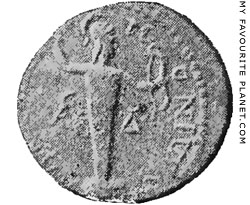
A coin of Lacedaemon (Sparta)
thought to depict the colossal
statue of Apollo Amyklaios.
Apollo standing, arms raised,
holding a spear in his right
hand and bow in the left. His
helmeted head facing right,
his body in the form of a pillar.
British Museum.
Source: J. G. Frazer, Pausanias's
Description of Greece, Volume 3,
fig. 52, page 356. Macmillan
and Co., London, 1898.
See also: Friedrich Imhoof-Blumer
and Percy Gardner, A numismatic
commentary on Pausanias,
page 59 and plate N XVII. Richard
Clay & Sons, London & Bungay,
1887. At the Internet Archive. |
|
The throne incorporated statues and was covered with a large number of reliefs depicting mythological figures and scenes, including several showing the exploits of Herakles and his apotheosis, as well as episodes from the Trojan War. After completing the work, Bathykles also dedicated images (presumably statues) of the Graces and Artemis Leukophryene.
"Bathycles of Magnesia, who made the throne of the Amyclaean, dedicated, on the completion of the throne, Graces and an image of Artemis Leucophryene. Whose pupil this Bathycles was, and who was king of Lacedaemon when he made the throne, I pass over; but I saw the throne and will describe its details."
The reliefs appear to have been well-known beyond the Peloponnese:
"To describe the reliefs one by one in detail would have merely bored my readers; but to be brief and concise (for the greater number of them are not unknown either)..."
Among the reliefs was a band of dancers that Pausanias said depicted fellow Magnesians who worked with him on the project.
"On the very top of the throne has been wrought a band of dancers, the Magnesians who helped Bathycles to make the throne."
On the colossal cult statue of the god:
"The part of the throne where the god would sit is not continuous; there are several seats, and by the side of each seat is left a wide empty space, the middle, whereon the image stands, being the widest of them.
I know of nobody who has measured the height of the image, but at a guess one would estimate it to be as much as thirty cubits [around 14 metres]. It is not the work of Bathycles, being old and uncouth; for though it has face, feet, and hands, the rest resembles a bronze pillar. On its head it has a helmet, in its hands a spear and a bow."
Pausanias, Description of Greece, Book 3, chapters 18-19. At Perseus Digital Library.
Herodotus wrote that when the Lacedaemonians (Spartans) sent representatives to Sardis to buy gold for the cult statue of Apollo on Mount Thornax, northeast of Sparta, the Lydian king Croesus gave it to them as a gift (Herodotus, Histories, Book 1, chapter 69, section 7). This probably occurred around 560-547 BC. Croesus' generosity to Sparta (and Delphi) was motivated by his search for Greek allies prior to his disastrous invasion of Persia. Around 700 years later Pausanias reported that the statue of Apollo at Thornax was similar in style to that at Amyklai, but that since the Spartans considered the latter to be more important they had used the gold from Croesus there.
"In Thornax, which you will reach as you go along, is an image of Apollo Pythaeus, made after the style of the one at Amyclae; the fashion of it I will describe when I come to speak of the latter. For in the eyes of the Lacedaemonians the cult of the Amyclaean is the more distinguished, so that they spent on adorning the image in Amyclae even the gold which Croesus the Lydian sent for Apollo Pythaeus."
Pausanias, Description of Greece, Book 3, chapter 10, section 8. At Perseus Digital Library.
This has led to speculation that Bathykles may have been involved in obtaining the gold from Croesus, that the "adorning" of the image may refer to the making of the Amyklai throne, and that he may have gilded the statue. It has even been conjectured that Croesus may have sent Bathykles and the other Magnesian workmen to Lacedaemon. On the other hand it has been suggested that the Magnesians may have been among the many artists and intellectuals from East Greece thought to have fled westwards to escape the political upheavals following the Lydian conquest of Greek cities in Anatolia, and the Persian takeover soon after (see, for example, Endoios, Lydos, Panyassis and Herodotus).
See: J. G. Frazer, Pausanias's Description of Greece, translated with a commentary, Volume 3 (of 6), page 351. Macmillan and Co., London, 1898. At the Internet Archive.
Elsewhere, Pausanias compared the throne to that of Pheidias' colossal statue of Zeus at Olympia, and said that the Amyklaian edifice could be entered.
"It is impossible to go under the throne [at Olympia], in the way we enter the inner part of the throne at Amyclae. At Olympia there are screens constructed like walls which keep people out."
Pausanias, Description of Greece, Book 5, chapter 11, section 4. At Perseus Digital Library.
He also wrote that the women of Sparta wove a new tunic for the Amyklaian statue every year (Book 3, chapter 16, section 2), in a similar way to the peplos made for the statue of Athena on the Athens Acropolis. A Lacedaemonian coin of the 3rd century BC shows the Amyklaian statue wearing a peplos.
See: Friedrich Imhoof-Blumer and Percy Gardner, A numismatic commentary on Pausanias, page 59 and plate N XVI. Reprinted from The Journal of Hellenic Studies, 1885, 1886, 1887. Richard Clay & Sons, London & Bungay, 1887. At the Internet Archive.
The sanctuary at Amyklai was first excavated in 1890 by the Greek archaeologist Christos Tsountas (Χρήστος Τσούντας, 1857-1934), and later by Adolf Furtwängler with E. Fiechter (1904), A. Skias with E. Fiechter (1907), Friderikos Versakis (1912), and E. Buschor with W. von Massov (1925). None of the reliefs of the throne have survived, but architectural members found at the site show that it was constructed using elements of the Ionic (rare in the Peloponnese during the Archaic period) and Doric orders. The finds are now in the Sparta Archaeological Museum. The only part of the throne left in situ is the foundation, around 1 metre high and 4 metres long. Furtwängler and others have made drawings as attempts to reconstruct the appearance of the throne (see drawing below). |
|
|
| |
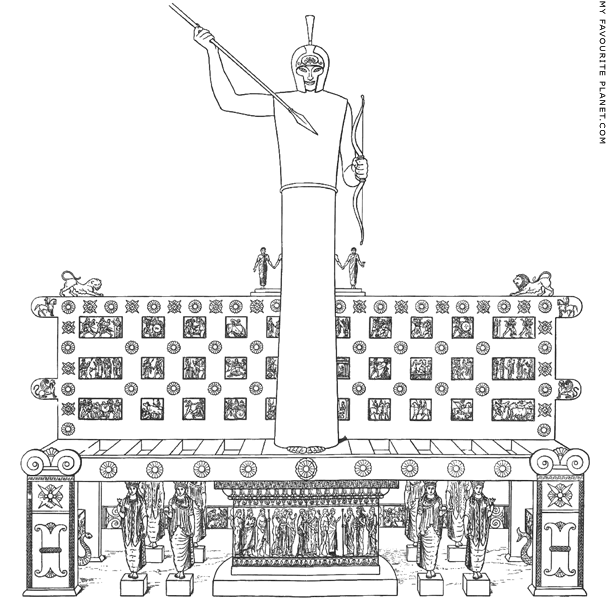
Adolf Furtwängler's conjectural reconstruction drawing
of the Throne of Apollo Amyklaios made by Bathykles.
Source: Adolf Furtwängler, Meisterwerke der griechischen Plastik, "Der Thron
des Amykläischen Apollon", pages 689-719, Fig. 135, page 706. Giesecke &
Devrient, Leipzig / Berlin, 1893. At Heidelberg University Digital Library. |
| |
Bryaxis
Βρύαξις or Βρύασσις
Mid 4th century BC
He was a contemporary of Leochares, Skopas, Praxiteles and Timotheos (Vitruvius, Ten books on architecture, Book 7, Introduction, section 13; Pliny the Elder, Natural history, Book 36, chapter 4).
Pliny the Elder mentioned five colossal statues of gods by Bryaxis, among other colossal statues in Rhodes, including the Colossus by Chares.
"In addition to these, there are five colossal statues of the gods, which were made by Bryaxis."
Pliny the Elder, Natural history, Book 34, chapter 18. At Perseus Digital Library.
Pliny also mentioned bronze statues by Bryaxis of Aesculapius [Asklepios] and "Seleucus".
"Bryaxis executed in brass statues of Aesculapius and Seleucus; Boedas a figure in adoration; Baton, an Apollo and a Juno [Hera], which are in the Temple of Concord at Rome."
Pliny the Elder, Natural history, Book 34, chapter 19.
It has been suggested that the name Seleucus, in the Latin text "Seleucum", should read "Salutem", implying that the statue depicted Hygieia, the goddess of health. This may at least partly be due to the mention by Pausanias of a statue of Asklepios and one of Hygieia by Bryaxis on the acropolis of Megara (the only mention of Bryaxis by Pausanias, Description of Greece, Book 1, chapter 40, section 6). Otherwise Seleucus could be Seleucus I Nicator (circa 358-281 BC), one of Alexander the Great's successors (see History of Pergamon). The works may have stood in Athens, since they are mentioned among other statues made there. Earlier in chapter 19, Pliny had named a Boedas as one of three sons of Lysippos. It appears that all these works (by Bryaxis, Boedas and Baton) were taken to Rome and set up in the Temple of Concord in Regio VIII (Region 8).
A marble statue of Dionysus at Knidos (Κνίδος), Caria:
"There are also at Cnidos some other statues in marble, the productions of illustrious artists; a Father Liber [Dionysus] by Bryaxis, another by Scopas, and a Minerva [Athena] by the same hand."
Pliny the Elder, Natural history, Book 36, chapter 4.
Around 350 BC Bryaxis made sculptures for the Mausoleum of Halicarnassus with Leochares, Skopas and perhaps Praxiteles and Timotheos.
"For men whose artistic talents are believed to have won them the highest renown for all time, and laurels forever green, devised and executed works of supreme excellence in this building. The decoration and perfection of the different facades were undertaken by different artists in emulation with each other: Leochares, Bryaxis, Scopas, Praxiteles, and, as some think, Timotheus. And the distinguished excellence of their art made that building famous among the seven wonders of the world."
Vitruvius, Ten books on architecture, Book 7, Introduction, section 13. At Perseus Digital Library.
According to Pliny the Elder, Bryaxis made the sculptures on the north side of the monument. He also wrote that Pythis (perhaps the sculptor and architect Pytheos mentioned by Virtuvius) made the chariot statue on top of the monument.
"Scopas had for rivals and contemporaries, Bryaxis, Timotheus, and Leochares, artists whom we are bound to mention together, from the fact that they worked together at the Mausoleum; such being the name of the tomb that was erected by his wife Artemisia in honour of Mausolus, a petty king of Caria, who died in the second year of the hundred and seventh Olympiad [351 BC].
It was through the exertions of these artists more particularly, that this work came to be reckoned one of the Seven Wonders of the World. The circumference of this building is, in all, four hundred and forty feet, and the breadth from north to south sixty-three, the two fronts being not so wide in extent. It is twenty-five cubits in height, and is surrounded with six-and-thirty columns, the outer circumference being known as the 'Pteron'.
The east side was sculptured by Scopas, the north by Bryaxis, the south by Timotheus, and the west by Leochares.
But, before their task was completed, Queen Artemisia died. They did not leave their work, however, until it was finished, considering that it was at once a memorial of their own fame and of the sculptor's art: and, to this day even, it is undecided which of them has excelled.
A fifth artist also took part in the work; for above the Pteron there is a pyramid erected, equal in height to the building below, and formed of four and twenty steps, which gradually taper upwards towards the summit; a platform, crowned with a representation of a four-horse chariot by Pythis. This addition makes the total height of the work one hundred and forty feet."
Pliny the Elder, Natural history, Book 36, chapter 4.
Artemisia (often referred to as Queen Artemisia II of Caria) was the sister and wife of Mausolus, thought to have died two years after him.
A marble base for a bronze tripod found in the Athens Agora and now in the National Archaeological Museum, Athens (Inv. No. 1733, see photos below), is inscribed with the signature of Bryaxis. Dated to around 350 BC, three sides of the base are decorated with almost identical low reliefs, thought not to have been made by Bryaxis, each depicting a horseman riding towards a large bronze tripod. The inscription names three Athenian tribal commanders (phylarchs) as victors in a mock cavalry battle (anthippasia), above the signature ΒΡΥΑΞΙΣ ΕΠΟΗΣΕΝ, in much smaller lettering. Inscription IG II² 3130. |
|
|
| |
Some scholars have attributed to Bryaxis a now-lost colossal cult statue of enthroned Serapis that stood in the Serapeion in Alexandria, Egypt. It was mentioned by Plutarch (Moralia, Of Isis and Osiris, 28), who said it was a statue of Plouton (Hades) with Cerberus (Κέρβερος, Kerberos) which Ptolemy I Soter (reigned 323-285 BC) had removed from Sinope on the Black Sea. Tacitus (Histories, Book 4, 83-84) related more or less the same story, saying that next to the statue of "Jupiter-Pluto" stood one of Proserpine (Persephone) which a Delphic oracle forbade Ptolemy to remove. He added that there were variants to this tale, in one of which Ptolemy III Euergetes (reigned 247-222 BC) was said to have brought it from Seleucia, and another in which Ptolemy I took it from Memphis. Later Clement of Alexandria (Protrepticus, 4, 43), citing the historian Athenodoros of Tarsos (1st century AD), wrote that it had been made by an artist named Bryaxis, "not the Athenian, but another of the same name".
Several extant sculptures, particularly several heads and busts of Serapis, are thought to be replicas of this statue (see photos below), and some have even been used as a basis for attempts to identify other works by the Athenian Bryaxis.
The Byzantine chronicler Kedrenos (Compendium Historiarium, 306B) wrote that Bryaxis made a statue of Apollo that stood at Daphne near Antioch, Syria. From descriptions of this statue by the Antiochian writer Libanios (Selected Works, 60, 8-12), Philostorgios (Historia Ecclesiastica) and Ammianus (22, 73, 1), it was a colossal acrolithic (wood and stone) figure of Apollo Kitharoidos, decorated with gold and with inset eyes of aquamarine. It stood in a temple, and was surrounded by statues of the Muses and city founders. It is thought to have been the Apollo shown on the city's coins, and to have been made around 300-281 BC. The destruction of the temple by fire, recorded by Libanios, may have occurred around 362 AD.
See: Ernest Arthur Gardner, A Handbook of Greek Sculptures Part 2, page 374. Macmillan and Co., London, 1897. |
|
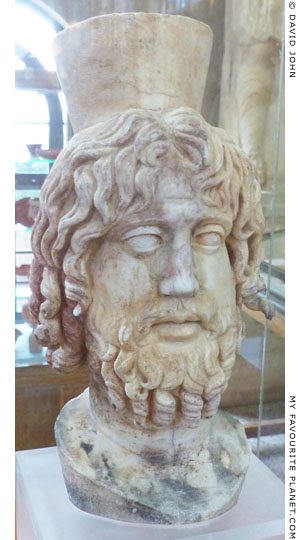
A marble head of Serapis wearing a polos
(also referred to as a calathus or modius).
Late 2nd century AD. From the South
Stoa of the Forum in Ancient Corinth.
Corinth Archaeological Museum.
Inv. No. S 2387. |
|
| |
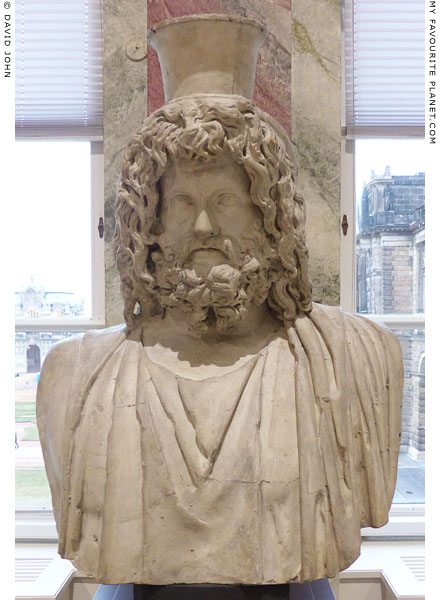
A plaster replica of a larger than lifesize marble bust of Serapis
wearing a polos. Some scholars believe that this and other
similar sculptures may be copied from the statue by Bryaxis.
Abguss-Sammlung, Semperbau, Dresden. Inv. No. ASN 2210.
From the plaster cast collection of Anton Raphael Mengs
(see the note on the Niobe page for further details).
The marble original is exhibited in the Sala Rotonda,
Museo Pio-Clementino, Vatican Museums. Inv. No. 689. |
| |
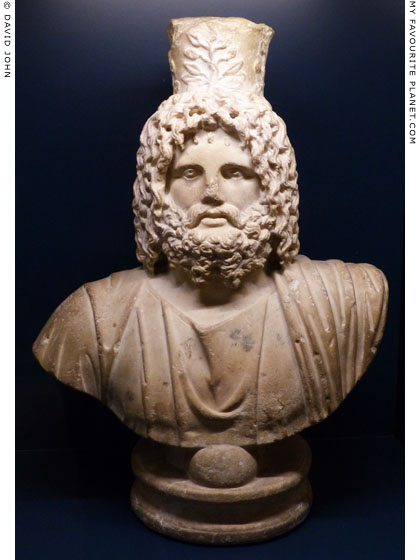
A marble bust of Serapis wearing a polos. The sphere between
the bust and its circular base is thought to signify that the god
is depicted here as Cosmocrator (Κοσμοκράτωρ, Kosmokrator),
the ruler of the entire cosmos.
2nd half of the 2nd century AD. Probably from Egypt.
Museum für Kunst und Gewerbe Hamburg.
Inv. No. 1974.81. Acquired with visitors' donations. |
| |
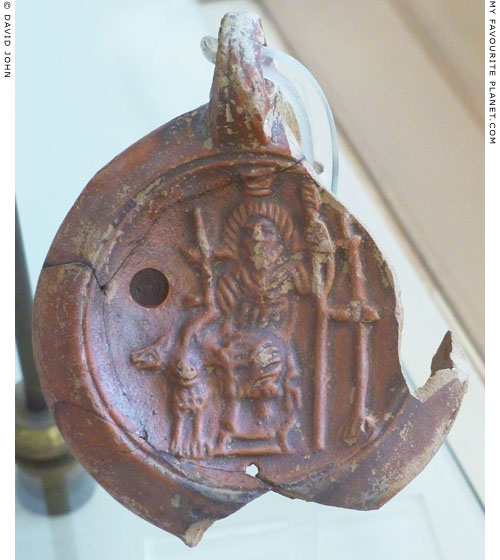
A relief of enthroned Serapis with a sceptre on the discus of a terracotta
oil lamp. As in depictions of Plouton (Hades), the god is shown wearing
a polos, and at his side is Kerberos, the multi-headed Underworld hound.
Late 1st - early 2nd century AD. From the Hellenistic-Roman
district of Akragas (Ἀκράγας, today Agrigento), Sicily.
As is often the case it is tempting to believe that such reliefs and paintings on
ceramics were modelled on statues, perhaps copies of the colossal cult statue of
enthroned Serapis of the Serapeion in Alexandria, Egypt, attributed to Bryaxis.
Agrigento Regional Archaeological Museum, Sicily. |
| |
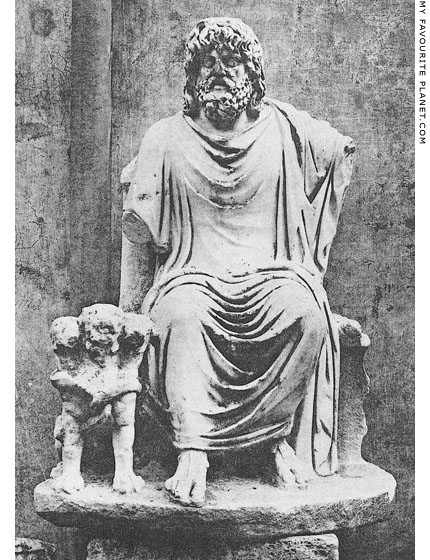
A marble statuette of Serapis enthroned, his polos (or modius)
and both arms are missing. Three-headed Kerberos, with a
snake entwined around its neck, sits by his right foot.
A rather battered sculpture, unrestored. Found with other ancient
sculptures in a nymphaeum (fountain) near the church of S. Eusebio,
on the Esquiline Hill, Rome. Parian marble. Height 190 cm.
It was described in an old catalogue of the Palazzo dei Conservatori,
Capitoline Museums, Rome, as standing among other sculptures,
architectural fragments and inscriptions in the Giardino (Garden) at the
back of the museum. The new Hall of Marco Aurelius was built over
the Giardino 1988-2005, and presumably these exhibits were moved
elsewhere. So far I have found no information on their present location.
See: Henry Stuart Jones, A catalogue of the ancient sculptures preserved in the municipal
collections of Rome: The sculptures of the Palazzo dei Conservatori (Volume 2 of 2, text;
Volume 1 contains the plates), "Statuette of Sarapis", Giardino No. 8, page 231 and plate 90.
Clarendon Press, Oxford, 1926. Both volumes online at Heidelberg University Digital Library. |
| |
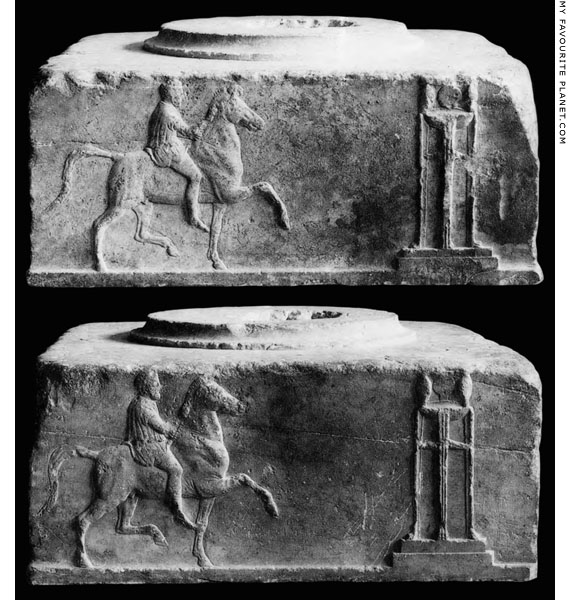
Two of three reliefs on the sides of the marble base for a bronze tripod signed by Bryaxis.
All three low reliefs show an almost identical scene of a man on horeback riding towarda a
large tripod. On the two sides shown in the photos above, the rider is on the left and the
tripod on the right. On the third side (not shown) the image is reversed. They represent
the three victorious Athenian tribal commanders (phylarchs) mentioned in the dedicatory
inscription on the fourth side above Bryaxis' signature ΒΡΥΑΞΙΣ ΕΠΟΗΣΕΝ (Bryaxis made it).
It is thought that only the tripod but not the reliefs were made by Bryaxis.
Around 350 BC. Found on 26th May 1891 north of the Hephaisteion in
the Athenian Agora, during the construction of the Athens-Piraeus railway
(the city's first metro line). Parian marble. Height 32 cm, width 75 cm.
National Archaeological Museum, Athens. Inv. No. 1733. Inscription IG II² 3130.
Image source: J. N. Svoronos, Das Athener Nationalmuseum, German
edition by W. Barth, Textband 1, No. 15, Inv. No. 1733, pages 163-167;
and Tafelband 1, Tafel 27. Beck & Barth, Athens, 1908.
A photo of the third relief appears on Tafel 26. |
| |
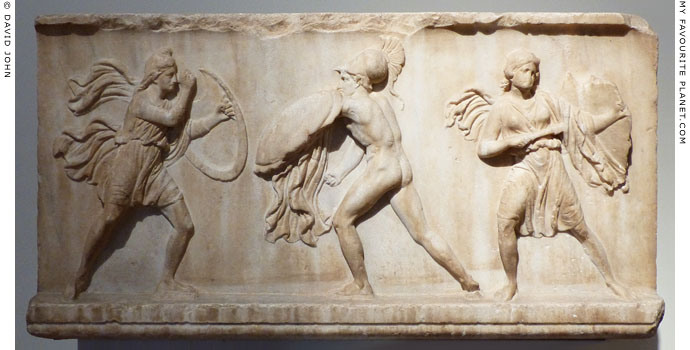
A marble slab with a relief depicting an Amazonomachy, attributed
to the school of Bryaxis or Timotheos. Perhaps part of a frieze
from a funerary monument in the form of a naiskos (small temple).
Mid 4th century BC. Found in Athens. Pentelic marble.
National Archaeological Museum, Athens. Inv. No. 3614.
The figures are comparable to those on the Amazonomachy frieze
of the Mausoleum of Halicarnassus, now in the British Museum. |
|
| |
| Sculptors |
C |
|
 |
|
| |
Chairestratos of Rhamnous
Χαιρέστρατος
From Rhamnous (Ῥαμνοῦς), near Marathon, Attica, late 4th - early 3rd century BC.
He is known from the inscription on the front of the base of a statue of the goddess Themis (see photo, right) found at Rhamnous (see above), which states that the statue was made by Chairestratos son of Chairedemos of Rhamnous and dedicated to Themis by Megakles of Rhamnous.
Μεγακλῆς Μεγακλ[έου]ς Ῥαμνούσ[ι]ος ἀνέθηκεν Θέμιδι στεφανωθεὶς ὑπὸ τῶν δημοτῶν δικαι-
οσύνης ἕνεκα ἐ[πὶ ἱ]ερείας Καλλιστοῦς
καὶ Φειδοστράτης Νεμέσει ἱερείας
καὶ νικήσας παισὶ καὶ ἀνδράσι γυμνασιαρχῶν
καὶ κωμωιδοῖς χορηγῶν.
Χαιρέστρατος Χαιρεδήμου
Ῥαμν<ο>ύσι<ο>ς ἐπ<ό>ησε
Megakles son of Megakles of Rhamnous dedicated (this) to Themis; he was crowned by the demesmen for his fairness when Kallistrato was priestess, and he won victories as boys' and men's trainer, and when Pheidostrate was priestess of Nemesis, as choregos [chorus-master] in the comedies.
Chairestratos son of Chairedemos
of Rhamnous made it.
Inscription IG II² 3109 (also: Pouilloux, Forteresse de Rhamnonte 39; SEG 40.178).
The statue is dated to around 300 BC, although some scholars have proposed dates as early as 320-316 BC, and others a little later than 287 BC, based on stylistic and epigraphical grounds as well as the consideration of political events.
A priest named Chairedemos, mentioned in an inscription 315/314 BC (IG II² 2726), is thought to have been the artist's father.
In 328/327 BC, during the archonship of Euthykritos, a Chairestratos son of Chairedemos of Rhamnous was among several men honoured and awarded a gold crown in an inscribed dedication and decree passed by the boule (council) of Athens (inscription IG II³ 1 360, from the Athens Agora). This mention was taken to refer to the sculptor's grandfather, but it has been suggested that it may have been the artist himself.
The signature of "Chairestratos of Athens" has also been found inscribed on a fragment of a marble statue support, discovered at Delphi in 1896 (see photo, below right):
Χαιρέστρατος
[Ἀθη]ναῖος
[ἐποί]ησεν
Chairestratos of Athens made this.
Inscription FD III 4:229.
Delphi Museum. Inv. No. 3620.
The support, in the form of a tree stump or rock with part of a garment, is thought to belong to a statuette of Apollo Kitharoidos. This has been taken as evidence that the artist who made the statue of Themis at Rhamnous was also working at Delphi.
In turn, from this it has been argued that Chairestratos was the master who made the "Column of the Dancers" (or "Akanthos Column") at Delphi around 335-332 BC (see photos below), and several other statues and stelai have been consequently attributed to him including a marble torso of a female statue (probably a personification, perhaps Tyche), dated around 330-310 BC, found in the Athens Agora (Agora Museum, Inv. No. S 2370). Counter to these arguments, the Themis statue has been described as mediocre and conservative, and considered an indifferent copy of a generic work, whereas the torso from the Agora, for example, is believed to be of much higher quality.
It has also been argued that since Megakles is mentioned as a choregos (χορηγός) on the Rhamnous dedication, the statue must predate the abolition of this tradition in 316 BC by Demetrius of Phaleron (Δημήτριος ὁ Φαληρεύς, circa 350-280 BC), who was appointed to govern Athens by the Macedonian king Cassander. However, the list of Megakles' achievements may be referring to his long-past glory days rather than recent events. |
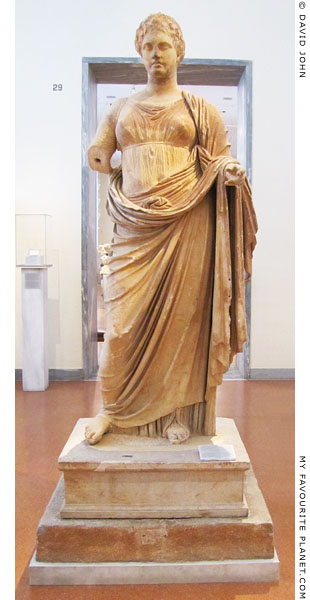
A marble statue of the goddess Themis
by Chairestratos from the smaller of
two adjacent temples in the sanctuary
of Nemesis at Rhamnous (see above).
Around 320-300 BC. Found in 1890 during
excavations by the Archaeological Society
of Athens, directed by Valerios Stais
(Βαλέριος Στάης, 1857-1923, Director
of the National Archaeological Museum,
Athens 1887-1923). Pentelic marble.
Height 222 cm.
The Titan Themis (Θέμις), a daughter of
Ouranos and Gaia, was the personification
of divine order and a goddess of justice.
At Rhamnous she was worshipped in the
same sanctuary as Nemesis. Either Pheidias
or Agorakritos of Paros made the cult statue
of Nemesis there in the 5th century BC
(see Agorakritos above).
The head of the figure was made separately
from the body. She probably held scales in
her left hand, and in her now missing right
hand a phiale (libation bowl).
National Archaeological Museum,
Athens. Inv. No. 231. |
| |
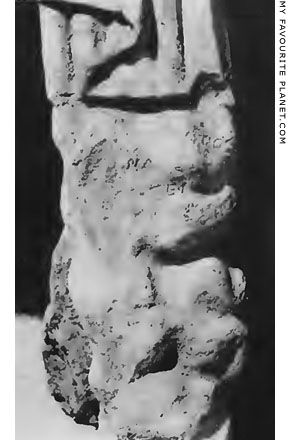
The fragment of statue support in Delphi
with the signature of Chairestratos.
Found 23 April 1896 below (south of) the
theatre. Height 63 cm, width 16.5 cm. Delphi Museum. Inv. No. 3620.
Source:
Théophile Homolle, Fouilles de Delphes,
Tome III, Fascicule 4, planche 33, 2.
Text on pages 273-274. École française
d'Athènes. E. De Boccard, Paris, 1930.
At the Internet Archive. |
| |
| |
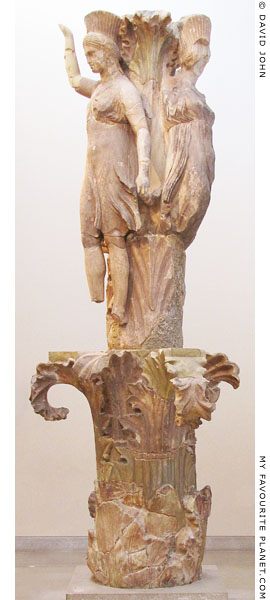 |
|
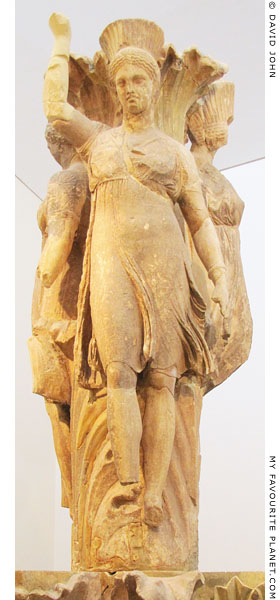 |
Restored fragments of the top of the "Column of the Dancers"
(or "Akanthos Column") which stood in front of the Temple of Apollo in Delphi.
Around 330 BC. Pentelic marble. Fragments discovered May - July 1894
on the terrace to the east and northeast of the temple.
Delphi Archaeological Museum.
|
|
The 13 metre tall column monument was one of a number of offerings at the northeast corner of the temple. According to a fragmentary inscription on its limestone base (see photo, right), it was a votive offering to Apollo by the Athenians.
[— — — — — — — — — — ἀν]έθηκ̣[εν Ἀπόλλωνι]
[— — — — — — — — — — ισμ[. . . .]Ι[......]
[— — — — — — — — τοῦ δήμο]υ̣ τοῦ Ἀθηναίων̣
. . . dedicated [to Apollo?]
. . . decree . . .
. . . [of the People?] of the Athenians.
Inscription FD III 4:462 (Fouilles de Delphes; also IG II³ 4, 17)
It is thought to have consisted of 5 fluted column drums, the base of each of which was encircled by large curling acanthus leaves in high relief. The capital was also decorated with a ring of acanthus leaves, on top of which stood three female figures, apparently dancing, with their backs against a central stalk, also covered by acanthus leaves.
Each of the 195 cm high figures wears a polos (or kalathos), and a knee-length transparent chitoniskos (short tunic) which clings to her body. With her left hand she holds the hem of her garment. On the base on which they stand, above the top of the capital's acanthus leaves and between each figure, stood a the leg of a large tripod, perhaps of bronze, the bowl of which was also supported by the raised right hand and polos of each of the females. The figures thus acted like caryatids. A limestone ompahalos found nearby (see photo, below right) may have been placed inside the bowl of the tripod.
There have been several theories concerning the possible significance of the column's form, the use of the acanthus motif and the identity of the female figures. According to one theory the column was an offering of Knidos, Caria and the women were the daughters of the semi divine hero Triopas, the city's founder (see Herodes Atticus). Others have seen the "dancers" as Thyiads, Attic followers of Dionysus who danced with the Delphian women on Mount Parnassus (see Dionysus), or the three daughters of Kekrops, the mythical king of Athens (see Athens Acropolis page 5). |
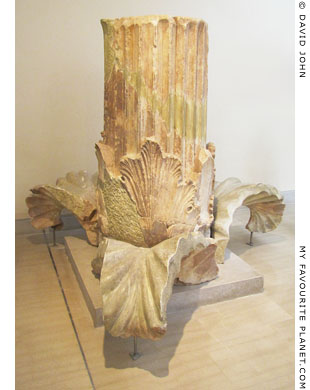
The base of the "Column of the Dancers".
Delphi Archaeological Museum. |
| |
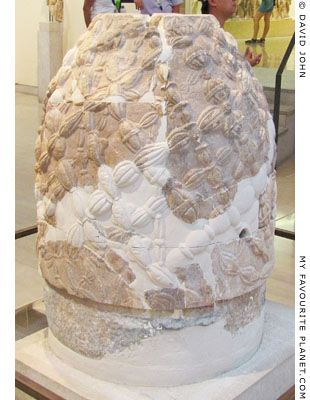
The limestone omphalos that may have
stood atop the "Column of the Dancers".
The relief covering its surface represents
the woollen net which is said to have
covered the original omphalos in the
adyton of the Temple of Apollo at Delphi.
Total height 123 cm, diameter 96 cm.
Delphi Archaeological Museum.
Inv. No. 8194. |
| |

A reconstruction drawing of the "Column
of the Dancers", made before the theory
that the omphalos stood in the tripod.
Source: Frederik Poulsen, Delphi, Fig. 113,
page 247. Gyldendal, London, 1920.
At the Internet Archive. |
| |
| |
Chares of Lindos
Χάρης ὁ Λίνδιος
4th century BC
Lindos, Rhodes
A pupil of Lysippos
He made the Colossus of Rhodes, a colossal bronze statue of the sun god Helios which stood in the city of Rhodes, one of the Seven Wonders of the Ancient World. Chares is said to have committed suicide after making an error in the estimate for the statue, and it was completed by Laches of Lindos. It was destroyed by an earthquake, and its remains were sold for scrap around 653 AD by the Saracen khalif Moavia after he captured Rhodes. It is said that nine hundred camels were required to remove the parts.
Pliny the Elder related the story of the Colossus of Rhodes when discussing other well-known Greek and Roman colossal statues:
"But that which is by far the most worthy of our admiration, is the colossal statue of the Sun, which stood formerly at Rhodes, and was the work of Chares the Lindian, a pupil of the above-named Lysippus; no less than seventy cubits in height.
This statue fifty-six years after it was erected, was thrown down by an earthquake; but even as it lies, it excites our wonder and admiration. Few men can clasp the thumb in their arms, and its fingers are larger than most statues. Where the limbs are broken asunder, vast caverns are seen yawning in the interior. Within it, too, are to be seen large masses of rock, by the weight of which the artist steadied it while erecting it.
It is said that it was twelve years before this statue was completed, and that three hundred talents were expended upon it; a sum raised from the engines of warfare which had been abandoned by King Demetrius [Demetrius Poliorcetes], when tired of the long-protracted siege of Rhodes.
In the same city there are other colossal statues, one hundred in number; but though smaller than the one already mentioned, wherever erected, they would, any one of them, have ennobled the place. In addition to these, there are five colossal statues of the gods, which were made by Bryaxis."
Pliny the Elder, Natural history, Book 34, chapter 18 ("The most celebrated statues in the city").
See also: the Colossus of Nero by Zenodoros |
|
|
| |
| Sculptors |
D |
|
 |
|
| |
| Name / Biographical information |
|
Works / References |
|
| |
Daidalos
(Latin, Daedalus)
Δαίδαλος (perhaps from δαιδάλλω, to work artfully)
Mythical or legendary sculptor, architect, engineer and inventor; the archetypal "father of artists" |
|
For further information see the Daidalos page of the MFP People section. |
|
|
| |
Daidalos of Sikyon
(Daedalus of Sicyon) Δαίδαλος Σικυώνιος
5th - 4th century BC
From Sikyon, northeastern Peloponnese
Pausanias (Description of Greece, Book 6, chapter 3, section 4) wrote that he was the pupil and son of Patrocles (Πατροκλές, Patrokles), who may have been the Patroclus mentioned by Pliny the Elder (Natural History, Book 34, chapter 19) as flourishing during the 95th Olympiad (400 BC), at the same time as Canachus (probably the younger Kanachos of Sikyon).
Earlier modern scholars thought he lived in the 7th or 6th century BC, perhaps due to the remark by Pausanias (Book 2, chapter 15, section 1) that the sculptors Dipoenos and Skyllis were held to be sons or pupils of Daidalos. Presumably, the reference was to the legendary Daidalos.
See also Doidalsas. |
|
"Daedalus, who is highly esteemed as a modeller in clay, made two brazen figures of youths using the body-scraper."
Pliny the Elder, Natural History, Book 34, chapter 19.
A statue of an athlete using the body-scraper (strigil) to remove oil and sweat after his victory in a contest is known as an apoxyomenos. There are a number of extant examples, though none which can with certainty attributed to Daidalos.
Pausanias (Description of Greece, Book 10, chapter 9, section 6) mentioned statues of Nike and Arkas ("who gave Arcadia its name") by Daidalos of Sikyon at Delphi. He also noted several statues he made of victorious athletes at Olympia.
"In the Altis by the side of Timosthenes are statues of Timon and of his son Aesypus, who is represented as a child seated on a horse. In fact the boy won the horse-race, while Timon was proclaimed victor in the chariot-race. The statues of Timon and of his son were made by Daedalus of Sicyon, who also made for the Eleans the trophy in the Altis commemorating the victory over the Spartans."
Pausanias, Description of Greece, Book 6, chapter 2, section 8.
"Next stands the statue of a boxer from Lepreus in Elis, whose name was Labax son of Euphron, and also that of Aristodemus, son of Thrasis, a boxer from Elis itself, who also won two victories at Pytho. The statue of Aristodemus is the work of Daedalus of Sicyon, the pupil and son of Patrocles."
Book 6, chapter 3, section 4.
"The statue of Eupolemus of Elis was made by Daedalus of Sicyon. The inscription on it informs us that Eupolemus won the foot-race for men at Olympia, and that he also received two Pythian crowns for the pentathlum and another at the Nemean games."
Book 6, chapter 3, section 7.
"Beside the statue of Pulydamas at Olympia stand two Arcadians and one Attic athlete. The statue of the Mantinean, Protolaus the son of Dialces, who won the boxing-match for boys, was made by Pythagoras of Rhegium; that of Narycidas, son of Damaretus, a wrestler from Phigalia, was made by Daedalus of Sicyon; that of the Athenian Callias, a pancratiast, is by the Athenian painter Micon. Nicodamus the Maenalian made the statue of the Maenalian pancratiast Androsthenes, the son of Lochaeus, who won two victories among the men."
Book 6, chapter 6, section 1. |
|
|
| |
Daidalos (of Bithynia)
Δαίδαλος (Latin, Daedalus)
3rd or 2nd century BC ?
This artist has been associated by some modern scholars with a sculptor believed to have been named Doidalsas.
The Byzantine Archbishop Eustathios of Thessaloniki (Εὐστάθιος Θεσσαλονίκης, circa 1115-1196 AD), in his commentary on the lost geographical work by Dionysius Periegetes (Διονύσιος ὁ Περιηγητής, 2nd or 3rd century AD), cited Arrian of Nikomedia (Ἀρριανός, circa 86-160 AD) as recording that a Daidalos (Δαίδαλος) made an admirable bronze statue of Zeus Stratios for Nikomedeia (Νικομήδεια, modern Izmit, Turkey), the capital of Bithynia (Βιθυνία), northwestern Anatolia. The city was founded around 264 BC by the Bithynian king Nikomedes I (ruled circa 280-255 BC), so this sculptor must have been working during or after this time.
See further details on the Doidalsas page. |
|
|
| |
Damatrios
Δαμάτριος
From Rhodes, 3rd - 2nd century BC
Marble relief frieze from the funerary monument for the philosopher Hieronymus of Tlos, depicting philosophers debating and scenes in the underworld. Signed by Damatrios. 3rd - 2nd century BC. Found in 1900 at Trianta, Rhodes, Greece. Altes Museum, Berlin. Inv. No. Sk 1888. |
|
|
| |
Damophon
Δαμοφῶν Φιλίππου Μεσσάνιος (Damophon, son of Philippos, of Messene)
2nd century BC
From Messene (Μεσσήνη), southwestern Peloponnese
One of the last Hellenistic sculptors working on large scale projects on the Greek mainland before the Roman conquest in 146 BC.
"We know from inscriptions that Damophon had two sons, Xenophilos and another whose name is lost. It is, therefore, possible that Xenophilos and Straton, the Argive sculptors, were his sons. Their subjects were similar, and their Asklepios, as shown on a coin, is identical with Damophon's."
Guy Dickens, Hellenistic sculpture, page 62. Clarendon Press, Oxford, 1920. At the Internet Archive.
Two bases (and a possible third) have been discovered with the inscribed signatures of Xenophilos and Straton of Argos, Ξενόφιλος καὶ Στράτων Ἅργεῖοι ἐποίσαν.
Loewy, Emanuel, Inschriften griechischer Bildhauer (Inscriptions of Greek sculptors), Nos. 261, 262 and 270. B. G. Teubner, Leipzig, 1885. At the Internet Archive.
Statues of Asklepios and Hygieia by Xenophilos and Straton (Ξενόφιλος καὶ Στράτων) at Argos were mentioned by Pausanias, who also wrote that there were seated statues of the two artists themselves in the sanctuary (self portraits?). He did not say that they were from Argos.
"The most famous sanctuary of Asclepius at Argos contains at the present day a white marble image of the god seated, and by his side stands Health [Hygieia]. There are also seated figures of Xenophilus and Straton, who made the images."
Pausanias, Description of Greece, Book 2, chapter 23, section 4. At Perseus Digital Library.
Pausanias was the only ancient author to mention Damophon, and wrote that he made several statues of deities for cities in the Peloponnese. Some of these statues are thought to be depicted on coins of the respective cities.
At Messene: Rhea, Artemis Laphria (Λαφρία, the epiphet of Artemis at Kalydon, Aetolia), Asklepios and his sons, Apollo, the Muses, Herakles, a personification of the city of Thebes, Epaminondas, Tyche and Artemis Phosphoros. Here Pausanias also wrote that Damophon restored the colossal chryselephantine (gold and ivory) cult statue of Zeus at Olympia, which had been made by Pheidias around 432 BC.
"There are sanctuaries of the gods Poseidon and Aphrodite, and, what is most deserving of mention, a statue of the Mother of the Gods [Μητρὸς θεῶν], of Parian marble, the work of Damophon, the artist who repaired the Zeus at Olympia with extreme accuracy when the ivory parted. Honours have been granted to him by the people of Elis.
By Damophon too is the so-called Laphria at Messene."
Pausanias, Description of Greece, Book 4, chapter 31, sections 6-7. At Perseus Digital Library.
"The most numerous statues and the most worth seeing are to be found in the sanctuary of Asclepius. For besides statues of the god and his sons, and besides statues of Apollo, the Muses and Heracles, the city of Thebes is represented and Epaminondas the son of Cleommis, Fortune [Τύχη, Tyche], and Artemis Bringer of Light [Ἄρτεμις Φωσφόρος, Artemis Phosphoros]. The stone statues are the work of Damophon (I know of no other Messenian sculptor of merit apart from him); the statue of Epaminondas is of iron and the work of some other artist."
Pausanias, Description of Greece, Book 4, chapter 31, section 10.
At Lykosoura, Arcadia: a colossal statue group of Demeter and Despoina (Persephone), sitting on a throne, with Artemis and the Titan Anytos, for the sanctuary of Despoina at Lykosoura, Arkadia.
Pausanias, Description of Greece, Book 8, chapter 37, sections 3-7. At Perseus Digital Library.
A large number of statue fragments from this group were discovered at the site, including the marble heads of Artemis, Demeter and Anytos. Dated 190-180 BC, the group is one of the few surviving monumental sculptures from the Hellenistic period yet found in the Peloponnese. National Archaeological Museum, Athens. Inv. Nos. 1734, 1735, 1736 and 1737.
At Aigion (Αἴγιον), Achaia, on the north coast of the Peloponnese, on the Gulf of Corinth, 38 km east of Patras: the acrolithic (wood and stone) cult statue for the Temple of Eileithyia (Εἰλείθυια, goddess of childbirth); and statues of Asklepios and Hygieia for the Asklepieion.
"At Aegium is an ancient sanctuary of Eileithyia, and her image is covered from head to foot with finely-woven drapery; it is of wood except the face, hands and feet, which are made of Pentelic marble. One hand is stretched out straight; the other holds up a torch. One might conjecture that torches are an attribute of Eileithyia because the pangs of women are just like fire. The torches might also be explained by the fact that it is Eileithyia who brings children to the light. The image is a work of Damophon the Messenian.
Not far from Eileithyia is a precinct of Asclepius, with images of him and of Health [Hygieia]. An iambic line on the pedestal says that the artist was Damophon the Messenian."
Pausanias, Description of Greece, Book 7, chapter 23, sections 5-7. At Perseus Digital Library.
The "finely-woven drapery" on the Eileithyia statue may have been similar to that on Damophon's statue of Despoina at Lykosoura, which was covered with reliefs of mythological figures (see Demeter and Persephone part 2). |
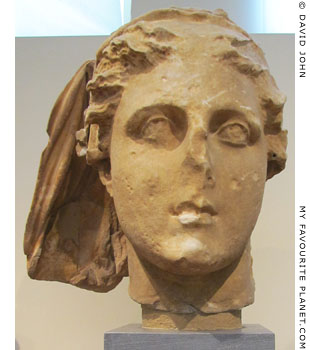
A marble head of Demeter from Lykosoura.
From the cult statue group by Damophon
of Messene in the temple of Despoina
(Persephone) at Lykosoura, Arcadia.
190-180 BC. Doliana marble.
Height 75 cm.
The back of the head is partly covered by
her himation (a cloak of woollen cloth).
National Archaeological Museum,
Athens. Inv. No. 1734. |
| |
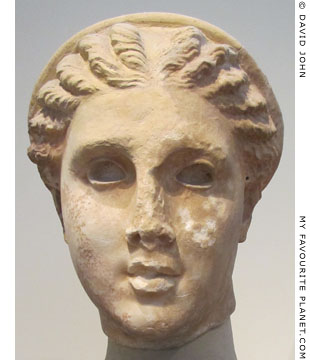
Head of Artemis from the Lykosoura
statue group by Damophon.
190-180 BC. Doliana marble. Height 48 cm.
The goddess wears a wreath. The eyes
were inlaid, and there are holes for
attaching metal jewellery. The torso
and parts of the limbs are kept in the
Lykosoura Archaeological Museum.
National Archaeological Museum,
Athens. Inv. No. 1735. |
| |
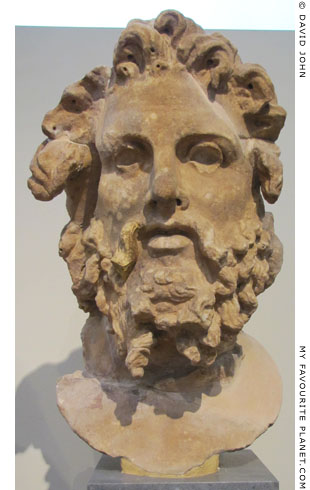
Head of the Titan Anytos from the
Lykosoura statue group by Damophon.
190-180 BC. Doliana marble. Height 74 cm.
The eyes were inlaid.
National Archaeological Museum,
Athens. Inv. No. 1736. |
| |
| |
At Megalopolis (Μεγαλόπολις), Arcadia: statues of Athena und Artemis for the Temple of Demeter and Kore (Persephone); a cult statue of Hermes; a cult statue of Aphrodite
"At the other end, the western, of the portico is an enclosure sacred to the Great Goddesses. The Great Goddesses are Demeter and the Maid [Μεγάλαι θεαὶ Δημήτηρ καὶ Κόρη], as I have already explained in my account of Messenia, and the Maid is called Saviour [Σώτειρα] by the Arcadians. Carved in relief before the entrance are, on one side Artemis, on the other Asclepius and Health.
Of the Great Goddesses, Demeter is of stone throughout, but the Saviour has drapery of wood. The height of each is about fifteen feet. The images . . . [are by Damophon *] and before them he made small maids in tunics reaching to the ankles, each of whom carries on her head a basket full of flowers. They are said to be daughters of Damophon, but those inclining to a more religious interpretation hold that they are Athena and Artemis gathering the flowers with Persephone.
By the side of Demeter there is also a Heracles about a cubit high. This Heracles, says Onomacritus in his poem, is one of those called Idaean Dactyls. Before it stands a table, on which are carved in relief two seasons, Pan with pipes, and Apollo playing the harp. There is also an inscription by them saying that they are among the first gods.
Nymphs too are carved on the table: Neda carrying an infant Zeus, Anthracia, another Arcadian nymph, holding a torch, and Hagno with a water-pot in one hand and a bowl in the other. Anchirhoe and Myrtoessa carry water-pots, with what is meant to be water coming down from them. Within the precinct is a temple of Zeus Friendly. Polycleitus of Argos made the image; it is like Dionysus in having buskins as footwear and in holding a beaker in one hand and a thyrsus in the other, but an eagle sitting on the thyrsus does not fit in with the received accounts of Dionysus.
Behind this temple is a small grove of trees surrounded by a wall; nobody may go inside, and before it are images of Demeter and the Maid some three feet high. Within the enclosure of the Great Goddesses is also a sanctuary of Aphrodite. Before the entrance are old wooden images of Hera, Apollo and the Muses, brought, it is said, from Trapezus, and in the temple are images made by Damophon, a wooden Hermes and a wooden Aphrodite with hands, face and feet of stone. The surname Deviser [Μαχανῖτιν] given to the goddess is, in my opinion, a most apt one; for very many are the devices, and most varied are the forms of speech invented by men because of Aphrodite and her works."
Pausanias, Description of Greece, Book 8, chapter 31, sections 1-6. At Perseus Digital Library.
* The words "are by Damophon" appear to be missing or corrupt in the manuscript, and have been omitted in the Perseus translation, although they are in the Greek text ("τά τε ἀγάλματα Δαμοφῶν...") and other translations and editions.
Pausanias, Description of Greece, Book 8, chapter 31, sections 1-6 (in ancient Greek). Pausaniae Graeciae Descriptio, 3 volumes. B. G. Teubner, Leipzig, 1903. At Perseus Digital Library.
During excavations at Messene, evidence has been discovered of the work and fame of Damophon in his home town and beyond. A 330 cm high Doric column found in the southeast corner of the Asklepieion is inscribed with decrees recording honours awarded posthumously to the artist Damophon, son of Philippos, from seven cities: Lykosoura, Lefkas, Krane in Kephallenia, Melos, Kythnos, Gerenia (on the border between Messenia and Lakonia) and Oiantheia (West Lokris). Specific statues made or repaired by Damophon are mentioned. It is thought that on top of the now missing column capital stood a statue of the sculptor.
Fragments of marble statues by Damophon, mentioned by Pausanias, were found in the west wing of the Asklepieion: the head and other fragments of a statue of Herakles found in Oikos N; the head of Apollo and fragments of the nine Muses, from a statue group which once stood on a semi-circular base found in Oikos Ξ. The faces of both heads bear remarkable similarities to those found in the temple of Despoina (Persephone) at Lykosoura.
See: Petros Themelis, Ancient Messene, pages 85-86, fig. 113 (the Doric column), and page 95, figs. 126, 127 (heads of Apollo and Herakles). Kapon Editions, Athens, 2019. |
|
|
| |
Deinokrates (or Stasikrates)
Δεινοκράτης
Sculptor, architect and city planner
4th - 3rd century BC
Sculptor, architect and city planner
From Macedonia or Rhodes
Thought to be the same artist mentioned but named differently by ancient authors:
Cheirokrates; Deinokrates or Dinocrates, Deinokrates of Rhodes; Dinochares; Diocles of Rhegium ; Stasikrates or Stasicrates; Timochares. |
|
This article is currently being rewritten.
A longer article about Deinokrates
will be appearing on a separate page. |
|
|
| |
Demetrios of Alopece
Δημήτριος
Early 4th century BC
From Alopece, a district of Athens
Ancient authors remarked on the lifelike realism of Demetrios' statues, in contrast to the idealized works by other sculptors such as Kresilas. |
|
|
| |
Demetrios Pteleasios
Δημήτριος Πτελεάσιος
Working in Athens, 2nd century BC
Known from his signature of an inscribed marble base of a statue of the poet Diomedes, found in 1862 at the Theatre of Dionysos, Athens (see photo on Athens Acropolis gallery page 36).
Διομήδης.
Δημήτριος Πτελεάσιος
ἐποίησεν.
Diomedes. Demetrios Pteleasios made it.
Theatre of Dionysos, Athens. Inv. No. NK 273.
Inscription IG II 2 4257.
He may be the Demetrios Philonos Pteleasios (Δημήτριος Φίλωνος Πτελεάσιος, Demetrios son of Philon, from Ptelea) known from signatures on other statue bases, including one found in 1938 near the Eleusinion, south of the Athenian Agora.
Δημήτριος Φίλωνος Πτελεάσιος ἐποίησεν
Demetrios son of Philon, from Ptelea, made it
Museum of the Ancient Agora, Athens. Inv. No. 1 5486. |
|
|
| |
Diogenes of Athens
Διογένης ὁ Ἀθηναῖος (Latin, Diogenes Atheniensis)
Late 1st century BC
From Athens, working in Rome during the reign of Augustus (27 BC - 14 AD).
According to Pliny (Natural History, Book 36, chapter 4), Diogenes made sculptures, including caryatids and the pediment, for the exterior of the Pantheon in Rome, commissioned by Marcus Agrippa (circa 63-12 BC). The Pantheon was badly damaged by two fires in the city, and it was later rebuilt during the reign of Hadrian (117-138 AD). The pediment, with the dedicatory inscription of Agrippa was reused, but the enormous columns supporting it were made of porphyry imported by Hadrian from the imperial quarries in Egypt. |
|
|
| |
Dionysios, son of Apollonios
Διονύσιος Απολλώνιου
Working in Athens in the mid 1st century AD, Roman Imperial period
Known only from the inscribed signature on the plinth of a Pentelic marble portrait statue of Julia Augusta Agrippina (today usually referred to as Agrippina Minor or Agrippina the Younger, 15-59 AD), the niece and fourth wife of Emperor Claudius (they married in 49 AD), and mother of Emperor Nero. It was found built into a later wall near the Heraion in Olympia (see photo, right).
Διονύσιος
Ἀπολλωνίου
Ἀθηναῖος
ἐποίει.
Dionysos, son of Apollonios, the Athenian made it.
Inscription IvO 646
The statue is believed to have been part of a group, including a colossal marble statue of Claudius, set up in the Metroon during the emperor's reign (41-54 AD) for the imperial cult. See Hegias (Roman period). |
|
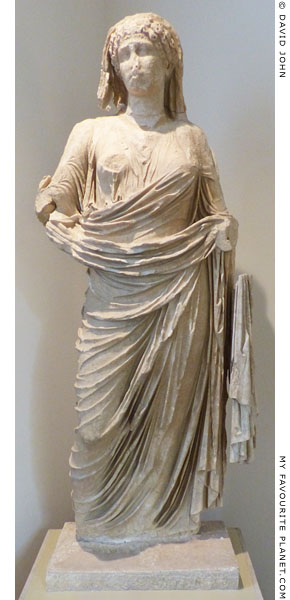
Marble portrait statue of Agrippina Minor
by Dionysios, son of Apollonios.
Mid 1st century AD. Found built into a
later wall near the Heraion in Olympia.
Pentelic marble. Height 214 cm.
Olympia Archaeological Museum.
Inv. No. Λ 143. |
|
| |
Dipoenos and Skyllis
Δίποινος καὶ Σκύλλις (Latin, Dipoenus et Scyllis)
Early 6th century
From Crete, they worked at Sikyon, northeastern Peloponnese.
Dipoenus and Scyllis were always mentioned together by ancient authors (Pliny the Elder, Pausanias). Pausanias mentioned ebony statues by them and referred to them as "pupils" or "sons" of Daidalos (Description of Greece, Book 2, chapter 15, section 1), perhaps in the same way as doctors were often referred to as "sons of Asklepios", the Greek god of healing (see also Endoios).
"The first artists who distinguished themselves in the sculpture of marble, were Dipoenus and Scyllis, natives of the Isle of Crete. At this period the Medians were still in power, and Cyrus [circa 600-530 BC] had not begun to reign in Persia; their date being about the fiftieth Olympiad [580 BC].
They afterwards repaired to Sicyon, a state which for a length of time was the adopted country of all such pursuits as these. The people of Sicyon had made a contract with them for the execution of certain statues of the gods; but, before completing the work, the artists complained of some injustice being done them, and retired to Aetolia. Immediately upon this, the state was afflicted with sterility and famine, and dreadful consternation was the result.
Upon enquiry being made as to a remedy for these evils, the Pythian Apollo [the Delphic Oracle] made answer, that Dipoenus and Scyllis must complete the statues of the gods; an object which was attained at the cost of great concessions and considerable sums of money. The statues were those of Apollo, Diana [Artemis], Hercules, and Minerva [Athena]; the last of which was afterwards struck by lightning.
Ambracia too, Argos, and Cleonae, were filled with productions of the sculptor Dipoenus.
All these artists, however, used nothing but the white marble of the Isle of Paros..."
Pliny, Natural history, Book 36, chapter 4. At Perseus Digital Library.
Pausanias remarked:
"On the road from Corinth to Argos is a small city Cleonae... Here there is a sanctuary of Athena, and the image is a work of Scyllis and Dipoenus. Some hold them to have been the pupils of Daedalus, but others will have it that Daedalus took a wife from Gortyn [in Crete], and that Dipoenus and Scyllis were his sons by this woman."
Pausanias, Description of Greece, Book 2, chapter 15, section 1. At Perseus Digital Library.
In Argos Pausanias noted statues by Dipoenos and Skyllis of the Dioskouroi, their wives and two sons:
"Going on a little further you see the grave of Argus, reputed to be the son of Zeus and Niobe, daughter of Phoroneus. After these comes a temple of the Dioscuri. The images represent the Dioscuri themselves and their sons, Anaxis and Mnasinous, and with them are their mothers, Hilaeira and Phoebe. They are of ebony wood, and were made by Dipoenus and Scyllis. The horses, too, are mostly of ebony, but there is a little ivory also in their construction."
Book 2, chapter 22, section 5.
We also learn from the author that the two artists had a school, and that two of their pupils, Tektaios and Angelion, made a cult statue of Apollo at Delos.
"On the citadel [of Troezen, eastern Peloponnese] is a temple of Athena, called Sthenias. The wooden image itself of the goddess was made by Callon of Aegina [Κάλλων Αἰγινήτης, early 5th century BC]. Callon was a pupil of Tectaeus and Angelion [Τεκταῖος καὶ Ἀγγελίων], who made the image of Apollo for the Delians. Angelion and Tectaeus were trained in the school of Dipoenus and Scyllis."
Book 2, chapter 32, section 5.
He also wrote that they may have taught Klearchos of Rhegion.
"They say that the artist was Clearchus of Rhegium, who is said by some to have been a pupil of Dipoenus and Scyllis, by others of Daedalus himself."
Book 3, chapter 17, section 6.
Three Lacedaemonian sculptors who worked at Olympia were also said to have been their pupils: Dorycleidas (Δορυκλείδας), Theocles (Θεοκλῆς) (Book 5, chapter 17, sections 1-2) and Dontas (Δόντας) (Book 6, chapter 19, section 14). |
|
|
| |
Doidalsas
Δοίδαλσας, also referred to as Daedalsas, Daidalos, Doedalsas or Doidalses
3rd or 2nd century BC ?
Some modern scholars have believed that a sculptor named Doidalsas made a statue of Aphrodite bathing and one of Zeus Stratios in Bithynia, northwestern Anatolia, during the Hellenistic period. Neither statue has survived, but the Aphrodite is believed to have been the original of which many copies of the "Crouching Aphrodite" type were made in the Roman period.
See further details on the Doidalsas page. |
|
|
| |
|
|
| |
| |
 |
| |
 |
| |
 |
| |
 |
| |
 |
| |
 |
| |
George Alvanos
rooms in
Kavala's historic Panagia District
Anthemiou 35,
Kavala, Greece
kavalarooms.gr
|
| |
Olive Garden Restaurant
Kastellorizo,
Greece
+30 22460 49 109
kastellorizo.de
|
| |
Papoutsis
Travel Agency
Kastellorizo,
Greece
+30 22460 49 286
greeklodgings.gr
|
| |
|

































































